14 Stress, Lifestyle, and Health

CHAPTER OUTLINE
14.1 What is Stress?
14.2 Stressors
14.3 Stress and Illness
14.4 Regulation of Stress
14.5 The Pursuit of Happiness
Of course, life is filled with many additional challenges beyond those incurred in college or the workplace. We might have concerns with financial security, difficulties with friends or neighbors, family responsibilities, and we may not have enough time to do the things we want to do. Even minor hassles—losing things, traffic jams, and loss of internet service—all involve pressure and demands that can make life seem like a struggle and that can compromise our sense of well-being. That is, all can be stressful in some way.
Scientific interest in stress, including how we adapt and cope, has been longstanding in psychology; indeed, after nearly a century of research on the topic, much has been learned and many insights have been developed. This chapter examines stress and highlights our current understanding of the phenomenon, including its psychological and physiological natures, its causes and consequences, and the steps we can take to master stress rather than become its victim.
14.1 What is Stress?
LEARNING OBJECTIVES
By the end of this section, you will be able to:
- Differentiate between stimulus-based and response-based definitions of stress
- Define stress as a process
- Differentiate between good stress and bad stress
- Describe the early contributions of Walter Cannon and Hans Selye to the stress research field
- Understand the physiological basis of stress and describe the general adaptation syndrome
The term stress as it relates to the human condition first emerged in scientific literature in the 1930s, but it did not enter the popular vernacular until the 1970s (Lyon, 2012). Today, we often use the term loosely in describing a variety of unpleasant feeling states; for example, we often say we are stressed out when we feel frustrated, angry, conflicted, overwhelmed, or fatigued. Despite the widespread use of the term, stress is a fairly vague concept that is difficult to define with precision.
Researchers have had a difficult time agreeing on an acceptable definition of stress. Some have conceptualized stress as a demanding or threatening event or situation (e.g., a high-stress job, overcrowding, and long commutes to work). Such conceptualizations are known as stimulus-based definitions because they characterize stress as a stimulus that causes certain reactions. Stimulus-based definitions of stress are problematic, however, because they fail to recognize that people differ in how they view and react to challenging life events and situations. For example, a conscientious student who has studied diligently all semester would likely experience less stress during final exams week than would a less responsible, unprepared student.
Others have conceptualized stress in ways that emphasize the physiological responses that occur when faced with demanding or threatening situations (e.g., increased arousal). These conceptualizations are referred to as response-based definitions because they describe stress as a response to environmental conditions. For example, the endocrinologist Hans Selye, a famous stress researcher, once defined stress as the “response of the body to any demand, whether it is caused by, or results in, pleasant or unpleasant conditions” (Selye, 1976, p. 74). Selye’s definition of stress is response-based in that it conceptualizes stress chiefly in terms of the body’s physiological reaction to any demand that is placed on it. Neither stimulus-based nor response-based definitions provide a complete definition of stress. Many of the physiological reactions that occur when faced with demanding situations (e.g., accelerated heart rate) can also occur in response to things that most people would not consider to be genuinely stressful, such as receiving unanticipated good news: an unexpected promotion or raise.
A useful way to conceptualize stress is to view it as a process whereby an individual perceives and responds to events that he appraises as overwhelming or threatening to his well-being (Lazarus & Folkman, 1984). A critical element of this definition is that it emphasizes the importance of how we appraise—that is, judge—demanding or threatening events (often referred to as stressors); these appraisals, in turn, influence our reactions to such events. Two kinds of appraisals of a stressor are especially important in this regard: primary and secondary appraisals. A primary appraisal involves judgment about the degree of potential harm or threat to well-being that a stressor might entail. A stressor would likely be appraised as a threat if one anticipates that it could lead to some kind of harm, loss, or other negative consequence; conversely, a stressor would likely be appraised as a challenge if one believes that it carries the potential for gain or personal growth. For example, an employee who is promoted to a leadership position would likely perceive the promotion as a much greater threat if she believed the promotion would lead to excessive work demands than if she viewed it as an opportunity to gain new skills and grow professionally. Similarly, a college student on the cusp of graduation may face the change as a threat or a challenge (Figure 14.2).

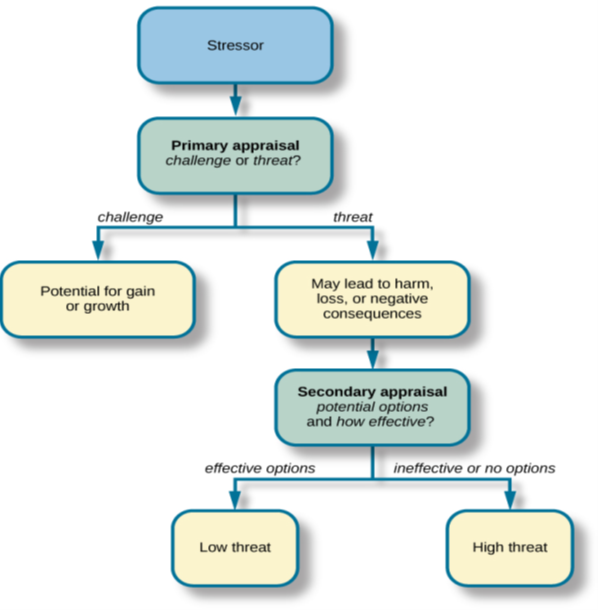
If a person appraises an event as harmful and believes that the demands imposed by the event exceed the available resources to manage or adapt to it, the person will subjectively experience a state of stress. In contrast, if one does not appraise the same event as harmful or threatening, she is unlikely to experience stress. According to this definition, environmental events trigger stress reactions by the way they are interpreted and the meanings they are assigned. In short, stress is largely in the eye of the beholder: it’s not so much what happens to you as it is how you respond (Selye, 1976).
Good Stress?
Although stress carries a negative connotation, at times it may be of some benefit. Stress can motivate us to do things in our best interests, such as study for exams, visit the doctor regularly, exercise, and perform to the best of our ability at work. Indeed, Selye (1974) pointed out that not all stress is harmful. He argued that stress can sometimes be a positive, motivating force that can improve the quality of our lives. This kind of stress, which Selye called eustress (from the Greek eu = “good”), is a good kind of stress associated with positive feelings, optimal health, and performance. A moderate amount of stress can be beneficial in challenging situations. For example, athletes may be motivated and energized by pregame stress, and students may experience similar beneficial stress before a major exam. Indeed, research shows that moderate stress can enhance both immediate and delayed recall of educational material. Male participants in one study who memorized a scientific text passage showed improved memory of the passage immediately after exposure to a mild stressor as well as one day following exposure to the stressor (Hupbach & Fieman, 2012).
Increasing one’s level of stress will cause performance to change in a predictable way. As shown in Figure 14.4, as stress increases, so do performance and general well-being (eustress); when stress levels reach an optimal level (the highest point of the curve), performance reaches its peak. A person at this stress level is colloquially at the top of his game, meaning he feels fully energized, focused, and can work with minimal effort and maximum efficiency. But when stress exceeds this optimal level, it is no longer a positive force—it becomes excessive and debilitating, or what Selye termed distress (from the Latin dis = “bad”). People who reach this level of stress feel burned out; they are fatigued, exhausted, and their performance begins to decline. If the stress remains excessive, health may begin to erode as well (Everly & Lating, 2002). A good example of distress is severe test anxiety. When students are feeling very stressed about a test, negative emotions combined with physical symptoms may make concentration difficult, thereby negatively affecting test scores.
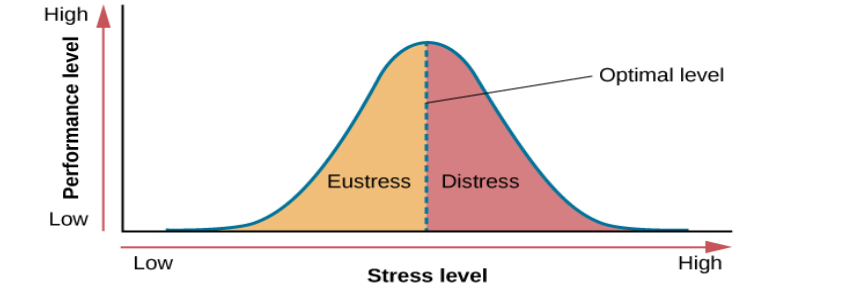
The Prevalence of Stress
Stress is everywhere and, as shown in Figure 14.5, it has been on the rise over the last several years. Each of us is acquainted with stress—some are more familiar than others. In many ways, stress feels like a load you just can’t carry—a feeling you experience when, for example, you have to drive somewhere in a blizzard, when you wake up late the morning of an important job interview, when you run out of money before the next pay period, and before taking an important exam for which you realize you are not fully prepared.
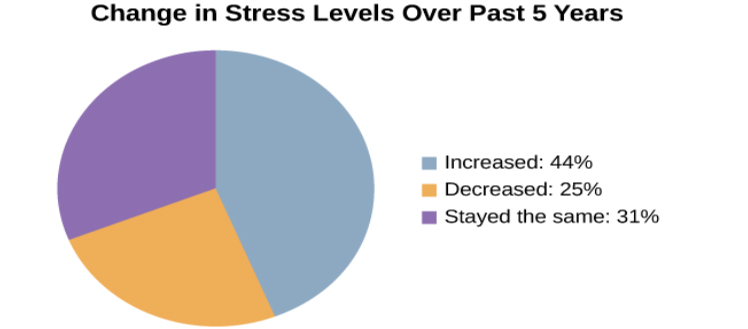
The scientific study of how stress and other psychological factors impact health falls within the realm of health psychology, a subfield of psychology devoted to understanding the importance of psychological influences on health, illness, and how people respond when they become ill (Taylor, 1999). Health psychology emerged as a discipline in the 1970s, a time during which there was increasing awareness of the role behavioral and lifestyle factors play in the development of illnesses and diseases (Straub, 2007). In addition to studying the connection between stress and illness, health psychologists investigate issues such as why people make certain lifestyle choices (e.g., smoking or eating unhealthy food despite knowing the potential adverse health implications of such behaviors). Health psychologists also design and investigate the effectiveness of interventions aimed at changing unhealthy behaviors. Perhaps one of the more fundamental tasks of health psychologists is to identify which groups of people are especially at risk for negative health outcomes, based on psychological or behavioral factors. For example, measuring differences in stress levels among demographic groups and how these levels change over time can help identify populations who may have an increased risk for illness or disease.
Figure 14.6 depicts the results of three national surveys in which several thousand individuals from different demographic groups completed a brief stress questionnaire; the surveys were administered in 1983, 2006, and 2009 (Cohen & Janicki-Deverts, 2012). All three surveys demonstrated higher stress in women than in men. Unemployed individuals reported high levels of stress in all three surveys, as did those with less education and income; retired persons reported the lowest stress levels. However, from 2006 to 2009 the greatest increase in stress levels occurred among men, Hispanics people aged 45–64, college graduates, and those with full-time employment. One interpretation of these findings is that concerns surrounding the 2008–2009 economic downturn (e.g., threat of or actual job loss and substantial loss of retirement savings) may have been especially stressful to college-educated employed men with limited time remaining in their working careers.
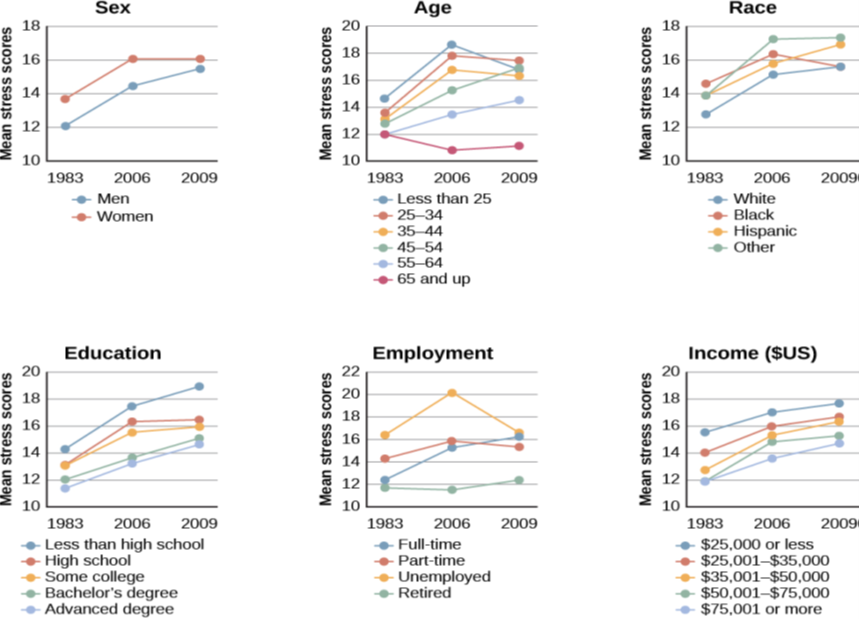
Early Contributions to the Study of Stress
As previously stated, scientific interest in stress goes back nearly a century. One of the early pioneers in the study of stress was Walter Cannon, an eminent American physiologist at Harvard Medical School (Figure 14.7). In the early part of the 20th century, Cannon was the first to identify the body’s physiological reactions to stress.

Cannon and the Fight-or-Flight Response
Imagine that you are hiking in the beautiful mountains of Colorado on a warm and sunny spring day. At one point during your hike, a large, frightening-looking black bear appears from behind a stand of trees and sits about 50 yards from you. The bear notices you, sits up, and begins to lumber in your direction. In addition to thinking, “This is definitely not good,” a constellation of physiological reactions begins to take place inside you. Prompted by a deluge of epinephrine (adrenaline) and norepinephrine (noradrenaline) from your adrenal glands, your pupils begin to dilate. Your heart starts to pound and speeds up, you begin to breathe heavily and perspire, you get butterflies in your stomach, and your muscles become tense, preparing you to take some kind of direct action. Cannon proposed that this reaction, which he called the fight-or-flight response, occurs when a person experiences very strong emotions—especially those associated with a perceived threat (Cannon, 1932). During the fight-or-flight response, the body is rapidly aroused by activation of both the sympathetic nervous system and the endocrine system (Figure 14.8). This arousal helps prepare the person to either fight or flee from a perceived threat.
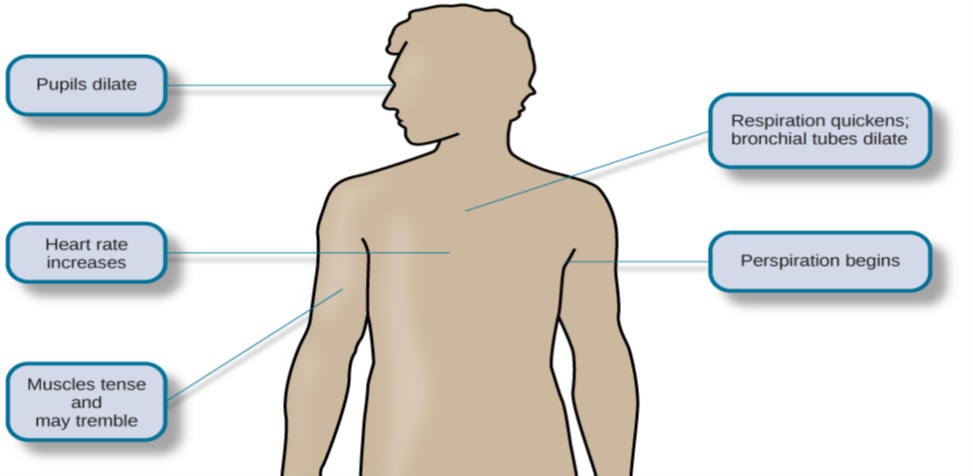
Selye and the General Adaptation Syndrome
Another important early contributor to the stress field was Hans Selye, mentioned earlier. He would eventually become one of the world’s foremost experts in the study of stress (Figure 14.9). As a young assistant in the biochemistry department at McGill University in the 1930s, Selye was engaged in research involving sex hormones in rats. Although he was unable to find an answer for what he was initially researching, he incidentally discovered that when exposed to prolonged negative stimulation (stressors)—such as extreme cold, surgical injury, excessive muscular exercise, and shock—the rats showed signs of adrenal enlargement, thymus and lymph node shrinkage, and stomach ulceration. Selye realized that these responses were triggered by a coordinated series of physiological reactions that unfold over time during continued exposure to a stressor. These physiological reactions were nonspecific, which means that regardless of the type of stressor, the same pattern of reactions would occur. What Selye discovered was the general adaptation syndrome, the body’s nonspecific physiological response to stress.

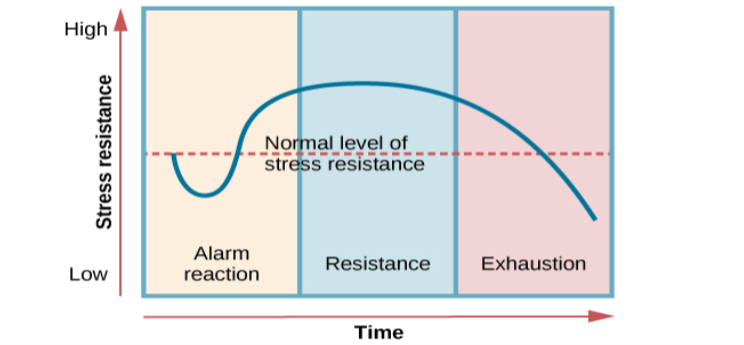
If exposure to a stressor continues over a longer period of time, the stage of exhaustion ensues. At this stage, the person is no longer able to adapt to the stressor: the body’s ability to resist becomes depleted as physical wear takes its toll on the body’s tissues and organs. As a result, illness, disease, and other permanent damage to the body—even death—may occur. If a missing child still remained missing after three months, the long-term stress associated with this situation may cause a parent to literally faint with exhaustion at some point or even to develop a serious and irreversible illness.
In short, Selye’s general adaptation syndrome suggests that stressors tax the body via a three-phase process—an initial jolt, subsequent readjustment, and a later depletion of all physical resources—that ultimately lays the groundwork for serious health problems and even death. It should be pointed out, however, that this model is a response-based conceptualization of stress, focusing exclusively on the body’s physical responses while largely ignoring psychological factors such as appraisal and interpretation of threats. Nevertheless, Selye’s model has had an enormous impact on the field of stress because it offers a general explanation for how stress can lead to physical damage and, thus, disease. As we shall discuss later, prolonged or repeated stress has been implicated in development of a number of disorders such as hypertension and coronary artery disease.
The Physiological Basis of Stress
What goes on inside our bodies when we experience stress? The physiological mechanisms of stress are extremely complex, but they generally involve the work of two systems—the sympathetic nervous system and the hypothalamic-pituitary-adrenal (HPA) axis. When a person first perceives something as stressful (Selye’s alarm reaction), the sympathetic nervous system triggers arousal via the release of adrenaline from the adrenal glands. Release of these hormones activates the fight-or-flight responses to stress, such as accelerated heart rate and respiration. At the same time, the HPA axis, which is primarily endocrine in nature, becomes especially active, although it works much more slowly than the sympathetic nervous system. In response to stress, the hypothalamus (one of the limbic structures in the brain) releases corticotrophin-releasing factor, a hormone that causes the pituitary gland to release adrenocorticotropic hormone (ACTH) (Figure 14.11). The ACTH then activates the adrenal glands to secrete a number of hormones into the bloodstream; an important one is cortisol, which can affect virtually every organ within the body. Cortisol is commonly known as a stress hormone and helps provide that boost of energy when we first encounter a stressor, preparing us to run away or fight. However, sustained elevated levels of cortisol weaken the immune system.
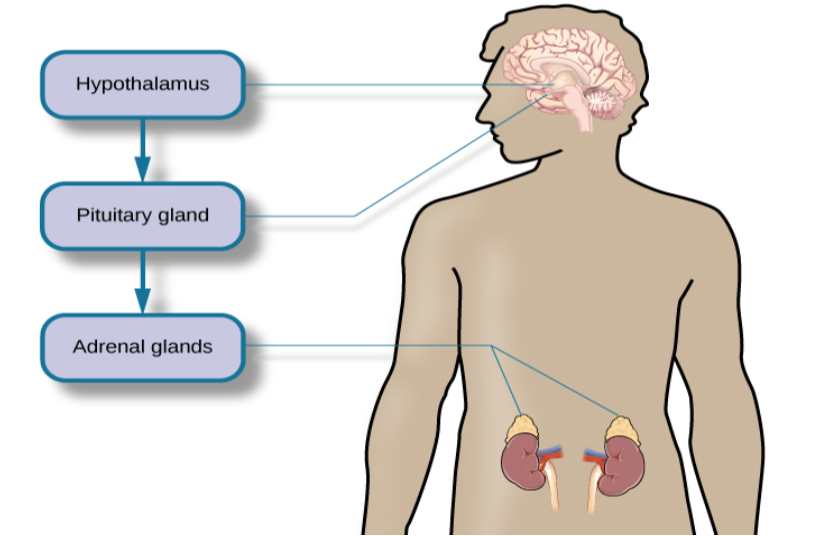
When stress is extreme or chronic, it can have profoundly negative consequences. For example, stress often contributes to the development of certain psychological disorders, including post-traumatic stress disorder, major depressive disorder, and other serious psychiatric conditions. Additionally, we noted earlier that stress is linked to the development and progression of a variety of physical illnesses and diseases. For example, researchers in one study found that people injured during the September 11, 2001, World Trade Center disaster or who developed post-traumatic stress symptoms afterward later suffered significantly elevated rates of heart disease (Jordan, Miller-Archie, Cone, Morabia, & Stellman, 2011). Another investigation yielded that self-reported stress symptoms among aging and retired Finnish food industry workers were associated with morbidity 11 years later. This study also predicted the onset of musculoskeletal, nervous system, and endocrine and metabolic disorders (Salonen, Arola, Nygård, & Huhtala, 2008). Another study reported that male South Korean manufacturing employees who reported high levels of work-related stress were more likely to catch the common cold over the next several months than were those employees who reported lower work-related stress levels (Park et al., 2011). Later, you will explore the mechanisms through which stress can produce physical illness and disease.
14.1 TEST YOURSELF
14.2 Stressors
LEARNING OBJECTIVES
By the end of this section, you will be able to:
- Describe different types of possible stressors
- Explain the importance of life changes as potential stressors
- Describe the Social Readjustment Rating Scale
- Understand the concepts of job strain and job burnout
For an individual to experience stress, he must first encounter a potential stressor. In general, stressors can be placed into one of two broad categories: chronic and acute. Chronic stressors include events that persist over an extended period of time, such as caring for a parent with dementia, long-term unemployment, or imprisonment. Acute stressors involve brief focal events that sometimes continue to be experienced as overwhelming well after the event has ended, such as falling on an icy sidewalk and breaking your leg (Cohen, Janicki-Deverts, & Miller, 2007). Whether chronic or acute, potential stressors come in many shapes and sizes. They can include major traumatic events, significant life changes, daily hassles, as well as other situations in which a person is regularly exposed to threat, challenge, or danger.
Traumatic Events
Some stressors involve traumatic events or situations in which a person is exposed to actual or threatened death or serious injury. Stressors in this category include exposure to military combat, threatened or actual physical assaults (e.g., physical attacks, sexual assault, robbery, childhood abuse), terrorist attacks, natural disasters (e.g., earthquakes, floods, hurricanes), and automobile accidents. Men, non-Whites, and individuals in lower socioeconomic status (SES) groups report experiencing a greater number of traumatic events than do women, Whites, and individuals in higher SES groups (Hatch & Dohrenwend, 2007). Some individuals who are exposed to stressors of extreme magnitude develop post-traumatic stress disorder (PTSD): a chronic stress reaction characterized by experiences and behaviors that may include intrusive and painful memories of the stressor event, jumpiness, persistent negative emotional states, detachment from others, angry outbursts, and avoidance of reminders of the event (American Psychiatric Association [APA], 2013).
Life Changes
Most stressors that we encounter are not nearly as intense as the ones described above. Many potential stressors we face involve events or situations that require us to make changes in our ongoing lives and require time as we adjust to those changes. Examples include death of a close family member, marriage, divorce, and moving (Figure 14.12).

In developing their scale, Holmes and Rahe asked 394 participants to provide a numerical estimate for each of the 43 items; each estimate corresponded to how much readjustment participants felt each event would require. These estimates resulted in mean value scores for each event—often called life change units (LCUs) (Rahe, McKeen, & Arthur, 1967). The numerical scores ranged from 11 to 100, representing the perceived magnitude of life change each event entails. Death of a spouse ranked highest on the scale with 100 LCUs, and divorce ranked second highest with 73 LCUs. In addition, personal injury or illness, marriage, and job termination also ranked highly on the scale with 53, 50, and 47 LCUs, respectively. Conversely, change in residence (20 LCUs), change in eating habits (15 LCUs), and vacation (13 LCUs) ranked low on the scale (Table 14.1). Minor violations of the law ranked the lowest with 11 LCUs. To complete the scale, participants checked yes for events experienced within the last 12 months. LCUs for each checked item are totaled for a score quantifying the amount of life change. Agreement on the amount of adjustment required by the various life events on the SRRS is highly consistent, even cross-culturally (Holmes & Masuda, 1974).
| Some Stressors on the Social Readjustment Rating Scale (Holmes & Rahe, 1967) | |
|---|---|
| Life event | Life change units |
| Death of a close family member | 63 |
| Personal injury or illness | 53 |
| Dismissal from work | 47 |
| Change in financial state | 38 |
| Change to different line of work | 36 |
| Outstanding personal achievement | 28 |
| Beginning or ending school | 26 |
| Change in living conditions | 25 |
| Change in working hours or conditions | 20 |
| Change in residence | 20 |
| Change in schools | 20 |
| Change in social activities | 18 |
| Change in sleeping habits | 16 |
| Change in eating habits | 15 |
| Minor violation of the law | 11 |
Extensive research has demonstrated that accumulating a high number of life change units within a brief period of time (one or two years) is related to a wide range of physical illnesses (even accidents and athletic injuries) and mental health problems (Monat & Lazarus, 1991; Scully, Tosi, & Banning, 2000). In an early demonstration, researchers obtained LCU scores for U.S. and Norwegian Navy personnel who were about to embark on a six-month voyage. A later examination of medical records revealed positive (but small) correlations between LCU scores prior to the voyage and subsequent illness symptoms during the ensuing six-month journey (Rahe, 1974). In addition, people tend to experience more physical symptoms, such as backache, upset stomach, diarrhea, and acne, on specific days in which self-reported LCU values are considerably higher than normal, such as the day of a family member’s wedding (Holmes & Holmes, 1970).
The Social Readjustment Rating Scale (SRRS) provides researchers a simple, easy-to-administer way of assessing the amount of stress in people’s lives, and it has been used in hundreds of studies (Thoits, 2010). Despite its widespread use, the scale has been subject to criticism. First, many of the items on the SRRS are vague; for example, death of a close friend could involve the death of a long-absent childhood friend that requires little social readjustment (Dohrenwend, 2006). In addition, some have challenged its assumption that undesirable life events are no more stressful than desirable ones (Derogatis & Coons, 1993). However, most of the available evidence suggests that, at least as far as mental health is concerned, undesirable or negative events are more strongly associated with poor outcomes (such as depression) than are desirable, positive events (Hatch & Dohrenwend, 2007). Perhaps the most serious criticism is that the scale does not take into consideration respondents’ appraisals of the life events it contains. As you recall, appraisal of a stressor is a key element in the conceptualization and overall experience of stress. Being fired from work may be devastating to some but a welcome opportunity to obtain a better job for others. The SRRS remains one of the most well-known instruments in the study of stress, and it is a useful tool for identifying potential stress-related health outcomes (Scully et al., 2000).
CONNECT THE CONCEPTS:
Correlational Research
The Holmes and Rahe Social Readjustment Rating Scale (SRRS) uses the correlational research method to identify the connection between stress and health. That is, respondents’ LCU scores are correlated with the number or frequency of self-reported symptoms indicating health problems. These correlations are typically positive—as LCU scores increase, the number of symptoms increase. Consider all the thousands of studies that have used this scale to correlate stress and illness symptoms: If you were to assign an average correlation coefficient to this body of research, what would be your best guess? How strong do you think the correlation coefficient would be? Why can’t the SRRS show a causal relationship between stress and illness? If it were possible to show causation, do you think stress causes illness or illness causes stress?
Hassles
Potential stressors do not always involve major life events. Daily hassles—the minor irritations and annoyances that are part of our everyday lives (e.g., rush hour traffic, l
ost keys, obnoxious coworkers, inclement weather, arguments with friends or family)—can build on one another and leave us just as stressed as life change events (Figure 14.13) (Kanner, Coyne, Schaefer, & Lazarus, 1981).

Occupation- Related Stressors
Stressors can include situations in which one is frequently exposed to challenging and unpleasant events, such as difficult, demanding, or unsafe working conditions. Although most jobs and occupations can at times be demanding, some are clearly more stressful than others (Figure 14.14). For example, most people would likely agree that a firefighter’s work is inherently more stressful than that of a florist. Equally likely, most would agree that jobs containing various unpleasant elements, such as those requiring exposure to loud noise (heavy equipment operator), constant harassment and threats of physical violence (prison guard), perpetual frustration (bus driver in a major city), or those mandating that an employee work alternating day and night shifts (hotel desk clerk), are much more demanding—and thus, more stressful—than those that do not contain such elements. Table 14.2 lists several occupations and some of the specific stressors associated with those occupations (Sulsky & Smith, 2005).
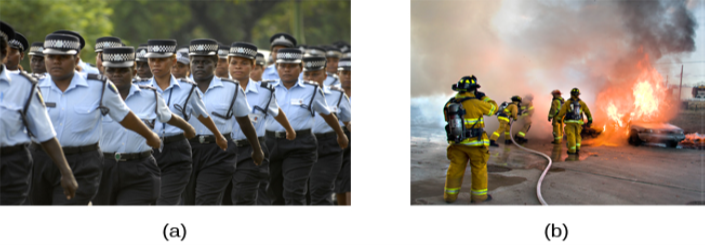
| Occupations and Their Related Stressors | |
|---|---|
| Occupation | Stressors Specific to Occupation |
| Police officer | physical dangers, excessive paperwork, dealing with court system, tense interactions, life-and-death decision making |
| Firefighter | uncertainty over whether a serious fire or hazard awaits after an alarm, potential for extreme physical danger |
| Social worker | little positive feedback from jobs or from the public, unsafe work environments, frustration in dealing with bureaucracy, excessive paperwork, sense of personal responsibility for clients, work overload |
| Teacher | Excessive paperwork, lack of adequate supplies or facilities, work overload, lack of positive feedback, threat of physical violence, lack of support from parents and administrators |
| Nurse | Work overload, heavy physical work, patient concerns (dealing with death and medical concerns), interpersonal problems with other medical staff (especially physicians) |
| Emergency medical worker | Unpredictable and extreme nature of the job, inexperience |
| Clerical and secretarial work | Few opportunities for advancement, unsupportive supervisors, work overload, lack of perceived control |
| Managerial work | Work overload, conflict and ambiguity in defining the managerial role, difficult work relationships |
Although the specific stressors for these occupations are diverse, they seem to share some common denominators such as heavy workload and uncertainty about and lack of control over certain aspects of a job. Chronic occupational stress contributes to job strain, a work situation that combines excessive job demands and workload with little discretion in decision-making or job control (Karasek & Theorell, 1990). Clearly, many occupations other than the ones listed in Table 14.2 involve at least a moderate amount of job strain in that they often involve heavy workloads and little job control (e.g., inability to decide when to take breaks). Such jobs are often low-status and include those of factory workers, postal clerks, supermarket cashiers, taxi drivers, and short-order cooks. Job strain can have adverse consequences on both physical and mental health; it has been shown to be associated with increased risk of hypertension (Schnall & Landsbergis, 1994), heart attacks (Theorell et al., 1998), recurrence of heart disease after a first heart attack (Aboa-Éboulé et al., 2007), significant weight loss or gain (Kivimäki et al., 2006), and major depressive disorder (Stansfeld, Shipley, Head, & Fuhrer, 2012). A longitudinal study of over 10,000 British civil servants reported that workers under 50 years old who earlier had reported high job strain were 68% more likely to later develop heart disease than were those workers under 50 years old who reported little job strain (Chandola et al., 2008).
Some people who are exposed to chronically stressful work conditions can experience job burnout, which is a general sense of emotional exhaustion and cynicism in relation to one’s job (Maslach & Jackson, 1981). Job burnout occurs frequently among those in human service jobs (e.g., social workers, teachers, therapists, and police officers). Job burnout consists of three dimensions. The first dimension is exhaustion—a sense that one’s emotional resources are drained or that one is at the end of her rope and has nothing more to give at a psychological level. Second, job burnout is characterized by depersonalization: a sense of emotional detachment between the worker and the recipients of his services, often resulting in callous, cynical, or indifferent attitudes toward these individuals. Third, job burnout is characterized by diminished personal accomplishment, which is the tendency to evaluate one’s work negatively by, for example, experiencing dissatisfaction with one’s job-related accomplishments or feeling as though one has categorically failed to influence others’ lives through one’s work.
Job strain appears to be one of the greatest risk factors leading to job burnout, which is most commonly observed in workers who are older (ages 55–64), unmarried, and whose jobs involve manual labor. Heavy alcohol consumption, physical inactivity, being overweight, and having a physical or lifetime mental disorder are also associated with job burnout (Ahola, et al., 2006). In addition, depression often co-occurs with job burnout. One large-scale study of over 3,000 Finnish employees reported that half of the participants with severe job burnout had some form of depressive disorder (Ahola et al., 2005). Job burnout is often precipitated by feelings of having invested considerable energy, effort, and time into one’s work while receiving little in return (e.g., little respect or support from others or low pay) (Tatris, Peeters, Le Blanc, Schreurs, & Schaufeli, 2001).
As an illustration, consider Tyre, a nursing assistant who worked in a nursing home. Tyre worked long hours for little pay in a difficult facility. Tyre’s supervisor was domineering, unpleasant, and unsupportive, as well as disrespectful of Tyre’s personal time, frequently informing them at the last minute they must work several additional hours after their shift ended or report to work on weekends. Tyre had very little autonomy at work. They had little input in day-to-day duties and how to perform them, and was not permitted to take breaks unless explicitly told by their supervisor. Tyre did not feel as though their hard work was appreciated, either by supervisory staff or by the residents of the home. Tyre was very unhappy over the low pay, and felt that many of the residents treated them disrespectfully.
After several years, Tyre began to hate their job. Tyre dreaded going to work in the morning, and gradually developed a callous, hostile attitude toward many of the residents. Eventually, they began to feel they could no longer help the nursing home residents. Tyre’s absenteeism from work increased, and one day they decided that they had had enough and quit. Tyre now has a job in sales, vowing never to work in nursing again.
Finally, our close relationships with friends and family—particularly the negative aspects of these relationships—can be a potent source of stress. Negative aspects of close relationships can include conflicts such as disagreements or arguments, lack of emotional support or confiding, and lack of reciprocity. All of these can be overwhelming, threatening to the relationship, and thus stressful. Such stressors can take a toll both emotionally and physically. A longitudinal investigation of over 9,000 British civil servants found that those who at one point had reported the highest levels of negative interactions in their closest relationship were 34% more likely to experience serious heart problems (fatal or nonfatal heart attacks) over a 13–15 year period, compared to those who experienced the lowest levels of negative interaction (De Vogli, Chandola & Marmot, 2007).
14.2 TEST YOURSELF
14.3 Stress and Illness
LEARNING OBJECTIVES
By the end of this section, you will be able to:
- Explain the nature of psychophysiological disorders
- Describe the immune system and how stress impacts its functioning
- Describe how stress and emotional factors can lead to the development and exacerbation of cardiovascular disorders, asthma, and tension headaches
In this section, we will discuss stress and illness. As stress researcher Robert Sapolsky (1998) describes, stress-related disease emerges, predominantly, out of the fact that we so often activate a physiological system that has evolved for responding to acute physical emergencies, but we turn it on for months on end, worrying about mortgages, relationships, and promotions. (p. 6)
The stress response, as noted earlier, consists of a coordinated but complex system of physiological reactions that are called upon as needed. These reactions are beneficial at times because they prepare us to deal with potentially dangerous or threatening situations (for example, recall our old friend, the fearsome bear on the trail). However, health is affected when physiological reactions are sustained, as can happen in response to ongoing stress.
Psychophysiological Disorders
If the reactions that compose the stress response are chronic or if they frequently exceed normal ranges, they can lead to cumulative wear and tear on the body, in much the same way that running your air conditioner on full blast all summer will eventually cause wear and tear on it. For example, the high blood pressure that a person under considerable job strain experiences might eventually take a toll on his heart and set the stage for a heart attack or heart failure. Also, someone exposed to high levels of the stress hormone cortisol might become vulnerable to infection or disease because of weakened immune system functioning (McEwen, 1998).
Physical disorders or diseases whose symptoms are brought about or worsened by stress and emotional factors are called psychophysiological disorders. The physical symptoms of psychophysiological disorders are real and they can be produced or exacerbated by psychological factors (hence the psycho and physiological in psychophysiological). A list of frequently encountered psychophysiological disorders is provided in Table 14.3.
| Types of Psychophysiological Disorders (adapted from Everly & Lating, 2002) | |
|---|---|
| Type of Psychophysiological Disorder | Examples |
| Cardiovascular | hypertension, coronary heart disease |
| Gastrointestinal | irritable bowel syndrome |
| Respiratory | asthma, allergy |
| Musculoskeletal | low back pain, tension headaches |
| Skin | acne, eczema, psoriasis |
Friedman and Booth-Kewley (1987) statistically reviewed 101 studies to examine the link between personality and illness. They proposed the existence of disease-prone personality characteristics, including depression, anger/hostility, and anxiety. Indeed, a study of over 61,000 Norwegians identified depression as a risk factor for all major disease-related causes of death (Mykletun et al., 2007). In addition, neuroticism—a personality trait that reflects how anxious, moody, and sad one is—has been identified as a risk factor for chronic health problems and mortality (Ploubidis & Grundy, 2009).
Below, we discuss two kinds of psychophysiological disorders about which a great deal is known: cardiovascular disorders and asthma. First, however, it is necessary to turn our attention to a discussion of the immune system—one of the major pathways through which stress and emotional factors can lead to illness and disease.
EVERYDAY CONNECTION
Social Status, Stress, and Health Care
Psychologists have long been aware that social status (e.g., wealth, privilege) is intimately tied to stress, health, and well-being. Some factors that contribute to high stress and poor health among people with lower social status include lack of control and predictability (e.g., greater unemployment) and resource inequality (e.g., less access to health care and other community resources) (Marmot & Sapolsky, 2014).
In the United States, resource inequalities tied to social status often create race and gender differences in health care. For example, African American women have the highest rates of emergency room visits and unmet health care needs compared to any other group, and this disparity increased significantly from 2006 to 2014 (Manuel, 2018). Lesbian, gay, bisexual, and transgender youth often experience poor quality of care as a result of stigma, lack of understanding, and insensitivity among health care professionals (Hafeez, Zeshan, Tahir, Jahan, & Naveed, 2017). One goal of the U.S. government’s Healthy People 2020 initiative is to eliminate gender and race disparities in health care. Their interactive dataset provides an updated snapshot of health disparities: https://www.healthypeople.gov/2020/data-search/health-disparities-data.
Stress and the Immune System
In a sense, the immune system is the body’s surveillance system. It consists of a variety of structures, cells, and mechanisms that serve to protect the body from invading microorganisms that can harm or damage the body’s tissues and organs. When the immune system is working as it should, it keeps us healthy and disease free by eliminating harmful bacteria, viruses, and other foreign substances that have entered the body (Everly & Lating, 2002).
Immune System Errors
Sometimes, the immune system will function erroneously. For example, sometimes it can go awry by mistaking your body’s own healthy cells for invaders and repeatedly attacking them. When this happens, the person is said to have an autoimmune disease, which can affect almost any part of the body. How an autoimmune disease affects a person depends on what part of the body is targeted. For instance, rheumatoid arthritis, an autoimmune disease that affects the joints, results in joint pain, stiffness, and loss of function. Systemic lupus erythematosus, an autoimmune disease that affects the skin, can result in rashes and swelling of the skin. Grave’s disease, an autoimmune disease that affects the thyroid gland, can result in fatigue, weight gain, and muscle aches (National Institute of Arthritis and Musculoskeletal and Skin Diseases [NIAMS], 2012).
In addition, the immune system may sometimes break down and be unable to do its job. This situation is referred to as immunosuppression, the decreased effectiveness of the immune system. When people experience immunosuppression, they become susceptible to any number of infections, illness, and diseases. For example, acquired immune deficiency syndrome (AIDS) is a serious and lethal disease that is caused by human immunodeficiency virus (HIV), which greatly weakens the immune system by infecting and destroying antibody-producing cells, thus rendering an untreated person vulnerable to any of a number of opportunistic infections (Powell, 1996).
Stressors and Immune Function
The question of whether stress and negative emotional states can influence immune function has captivated researchers for over three decades, and discoveries made over that time have dramatically changed the face of health psychology (Kiecolt-Glaser, 2009). Psychoneuroimmunology is the field that studies how psychological factors such as stress influence the immune system and immune functioning. The term psychoneuroimmunology was first coined in 1981, when it appeared as the title of a book that reviewed available evidence for associations between the brain, endocrine system, and immune system (Zacharie, 2009). To a large extent, this field evolved from the discovery that there is a connection between the central nervous system and the immune system.
Some of the most compelling evidence for a connection between the brain and the immune system comes from studies in which researchers demonstrated that immune responses in animals could be classically conditioned (Everly & Lating, 2002). For example, Ader and Cohen (1975) paired flavored water (the conditioned stimulus) with the presentation of an immunosuppressive drug (the unconditioned stimulus), causing sickness (an unconditioned response). Not surprisingly, rats exposed to this pairing developed a conditioned aversion to the flavored water. However, the taste of the water itself later produced immunosuppression (a conditioned response), indicating that the immune system itself had been conditioned. Many subsequent studies over the years have further demonstrated that immune responses can be classically conditioned in both animals and humans (Ader & Cohen, 2001). Thus, if classical conditioning can alter immunity, other psychological factors should be capable of altering it as well.
Hundreds of studies involving tens of thousands of participants have tested many kinds of brief and chronic stressors and their effects on the immune system (e.g., public speaking, medical school examinations, unemployment, marital discord, divorce, death of spouse, burnout and job strain, caring for a relative with Alzheimer’s disease, and exposure to the harsh climate of Antarctica). It has been repeatedly demonstrated that many kinds of stressors are associated with poor or weakened immune functioning (Glaser & Kiecolt-Glaser, 2005; Kiecolt-Glaser, McGuire, Robles, & Glaser, 2002; Segerstrom & Miller, 2004).
When evaluating these findings, it is important to remember that there is a tangible physiological connection between the brain and the immune system. For example, the sympathetic nervous system innervates immune organs such as the thymus, bone marrow, spleen, and even lymph nodes (Maier, Watkins, & Fleshner, 1994). Also, we noted earlier that stress hormones released during hypothalamic-pituitary-adrenal (HPA) axis activation can adversely impact immune function. One way they do this is by inhibiting the production of lymphocytes, white blood cells that circulate in the body’s fluids that are important in the immune response (Everly & Lating, 2002).
Some of the more dramatic examples demonstrating the link between stress and impaired immune function involve studies in which volunteers were exposed to viruses. The rationale behind this research is that because stress weakens the immune system, people with high stress levels should be more likely to develop an illness compared to those under little stress. In one memorable experiment using this method, researchers interviewed 276 healthy volunteers about recent stressful experiences (Cohen et al., 1998). Following the interview, these participants were given nasal drops containing the cold virus (in case you are wondering why anybody would ever want to participate in a study in which they are subjected to such treatment, the participants were paid $800 for their trouble). When examined later, participants who reported experiencing chronic stressors for more than one month—especially enduring difficulties involving work or relationships—were considerably more likely to have developed colds than were participants who reported no chronic stressors (Figure 14.15).
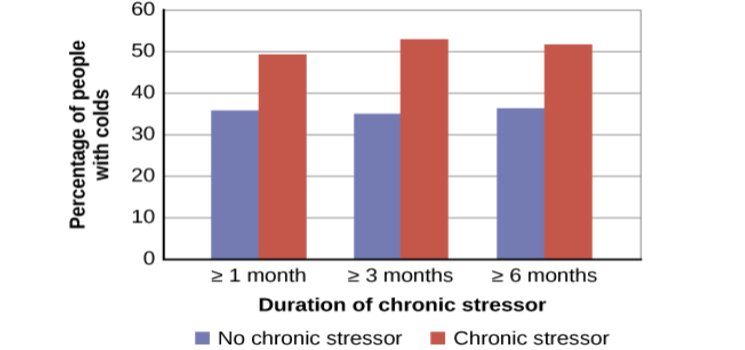
Other studies have demonstrated that stress slows down wound healing by impairing immune responses important to wound repair (Glaser & Kiecolt-Glaser, 2005). In one study, for example, skin blisters were induced on the forearm. Subjects who reported higher levels of stress produced lower levels of immune proteins necessary for wound healing (Glaser et al., 1999). Stress, then, is not so much the sword that kills the knight, so to speak; rather, it’s the sword that breaks the knight’s shield, and your immune system is that shield.
DIG DEEPER
Stress and Aging: A Tale of Telomeres
Have you ever wondered why people who are stressed often seem to have a haggard look about them? A pioneering study from 2004 suggests that the reason is because stress can actually accelerate the cell biology of aging.
Stress, it seems, can shorten telomeres, which are segments of DNA that protect the ends of chromosomes. Shortened telomeres can inhibit or block cell division, which includes growth and proliferation of new cells, thereby leading to more rapid aging (Sapolsky, 2004). In the study, researchers compared telomere lengths in the white blood cells in mothers of chronically ill children to those of mothers of healthy children (Epel et al., 2004). Mothers of chronically ill children would be expected to experience more stress than would mothers of healthy children. The longer a mother had spent caring for her ill child, the shorter her telomeres (the correlation between years of caregiving and telomere length was r = -.40). In addition, higher levels of perceived stress were negatively correlated with telomere size (r = -.31). These researchers also found that the average telomere length of the most stressed mothers, compared to the least stressed, was similar to what you would find in people who were 9–17 years older than they were on average.
Numerous other studies since have continued to find associations between stress and eroded telomeres (Blackburn & Epel, 2012). Some studies have even demonstrated that stress can begin to erode telomeres in childhood and perhaps even before children are born. For example, childhood exposure to violence (e.g., maternal domestic violence, bullying victimization, and physical maltreatment) was found in one study to accelerate telomere erosion from ages 5 to 10 (Shalev et al., 2013). Another study reported that young adults whose mothers had experienced severe stress during their pregnancy had shorter telomeres than did those whose mothers had stress-free and uneventful pregnancies (Entringer et al., 2011). Further, the corrosive effects of childhood stress on telomeres can extend into young adulthood. In an investigation of over 4,000 U.K. women ages 41–80, adverse experiences during childhood (e.g., physical abuse, being sent away from home, and parent divorce) were associated with shortened telomere length (Surtees et al., 2010), and telomere size decreased as the amount of experienced adversity increased (Figure 14.16).
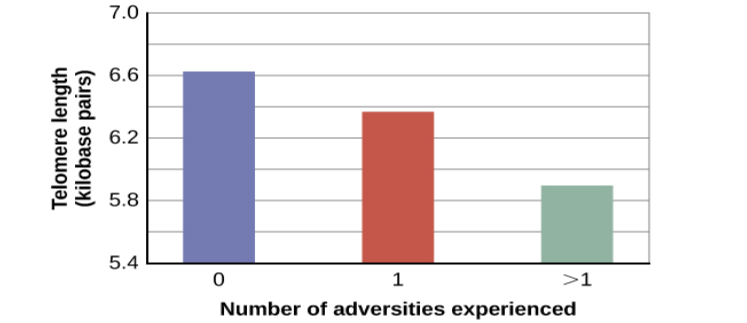
Cardiovascular Disorders
The cardiovascular system is composed of the heart and blood circulation system. For many years, disorders that involve the cardiovascular system—known as cardiovascular disorders—have been a major focal point in the study of psychophysiological disorders because of the cardiovascular system’s centrality in the stress response (Everly & Lating, 2002). Heart disease is one such condition. Each year, heart disease causes approximately one in three deaths in the United States, and it is the leading cause of death in the developed world (Centers for Disease Control and Prevention [CDC], 2011; Shapiro, 2005).
The symptoms of heart disease vary somewhat depending on the specific kind of heart disease one has, but they generally involve angina—chest pains or discomfort that occur when the heart does not receive enough blood (Office on Women’s Health, 2009). The pain often feels like the chest is being pressed or squeezed; burning sensations in the chest and shortness of breath are also commonly reported. Such pain and discomfort can spread to the arms, neck, jaws, stomach (as nausea), and back (American Heart Association [AHA], 2012a) (Figure 14.17).
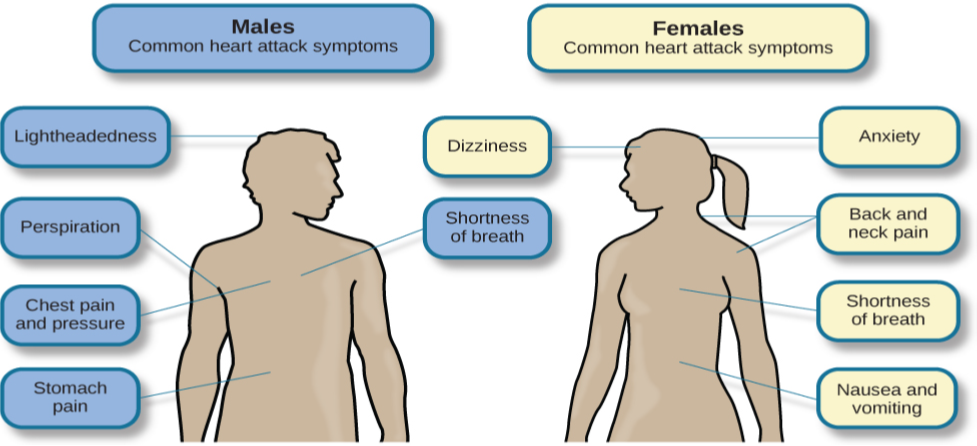
Many risk factors contributing to cardiovascular disorders have been identified. These risk factors include social determinants such as aging, income, education, and employment status, as well as behavioral risk factors that include unhealthy diet, tobacco use, physical inactivity, and excessive alcohol consumption; obesity and diabetes are additional risk factors (World Health Organization [WHO], 2013).
Over the past few decades, there has been much greater recognition and awareness of the importance of stress and other psychological factors in cardiovascular health (Nusair, Al-dadah, & Kumar, 2012). Indeed, exposure to stressors of many kinds has also been linked to cardiovascular problems; in the case of hypertension, some of these stressors include job strain (Trudel, Brisson, & Milot, 2010), natural disasters (Saito, Kim, Maekawa, Ikeda, & Yokoyama, 1997), marital conflict (Nealey-Moore, Smith, Uchino, Hawkins, & Olson-Cerny, 2007), and exposure to high traffic noise levels at one’s home (de Kluizenaar, Gansevoort, Miedema, & de Jong, 2007). Perceived discrimination appears to be associated with hypertension among African Americans (Sims et al., 2012). In addition, laboratory-based stress tasks, such as performing mental arithmetic under time pressure, immersing one’s hand into ice water (known as the cold pressor test), mirror tracing, and public speaking have all been shown to elevate blood pressure (Phillips, 2011).
Are You Type A or Type B?
Sometimes research ideas and theories emerge from seemingly trivial observations. In the 1950s, cardiologist Meyer Friedman was looking over his waiting room furniture, which consisted of upholstered chairs with armrests. Friedman decided to have these chairs reupholstered. When the man doing the reupholstering came to the office to do the work, he commented on how the chairs were worn in a unique manner—the front edges of the cushions were worn down, as were the front tips of the arm rests. It seemed like the cardiology patients were tapping or squeezing the front of the armrests, as well as literally sitting on the edge of their seats (Friedman & Rosenman, 1974). Were cardiology patients somehow different than other types of patients? If so, how?
After researching this matter, Friedman and his colleague, Ray Rosenman, came to understand that people who are prone to heart disease tend to think, feel, and act differently than those who are not. These individuals tend to be intensively driven workaholics who are preoccupied with deadlines and always seem to be in a rush. According to Friedman and Rosenman, these individuals exhibit Type A behavior pattern; those who are more relaxed and laid-back were characterized as Type B (Figure 14.18). In a sample of Type As and Type Bs, Friedman and Rosenman were startled to discover that heart disease was over seven times more frequent among the Type As than the Type Bs (Friedman & Rosenman, 1959).

An example of a person who exhibits Type A behavior pattern is Jeffrey. Even as a child, Jeffrey was intense and driven. He excelled at school, was captain of the swim team, and graduated with honors from an Ivy League college. Jeffrey never seems able to relax; he is always working on something, even on the weekends. However, Jeffrey always seems to feel as though there are not enough hours in the day to accomplish all he feels he should. He volunteers to take on extra tasks at work and often brings his work home with him; he often goes to bed frustrated late at night because he feels that he has not done enough. Jeffrey is quick tempered with his coworkers; he often becomes noticeably agitated when dealing with those coworkers he feels work too slowly or whose work does not meet his standards. He typically reacts with hostility when interrupted at work. He has experienced problems in his marriage over his lack of time spent with family. When caught in traffic during his commute to and from work, Jeffrey incessantly pounds on his horn and swears loudly at other drivers. When Jeffrey was 52, he suffered his first heart attack.
By the 1970s, a majority of practicing cardiologists believed that Type A behavior pattern was a significant risk factor for heart disease (Friedman, 1977). Indeed, a number of early longitudinal investigations demonstrated a link between Type A behavior pattern and later development of heart disease (Rosenman et al., 1975; Haynes, Feinleib, & Kannel, 1980).
Subsequent research examining the association between Type A and heart disease, however, failed to replicate these earlier findings (Glassman, 2007; Myrtek, 2001). Because Type A theory did not pan out as well as they had hoped, researchers shifted their attention toward determining if any of the specific elements of Type A predict heart disease.
Extensive research clearly suggests that the anger/hostility dimension of Type A behavior pattern may be one of the most important factors in the development of heart disease. This relationship was initially described in the Haynes et al. (1980) study mentioned above: Suppressed hostility was found to substantially elevate the risk of heart disease for both men and women. Also, one investigation followed over 1,000 male medical students from 32 to 48 years. At the beginning of the study, these men completed a questionnaire assessing how they react to pressure; some indicated that they respond with high levels of anger, whereas others indicated that they respond with less anger. Decades later, researchers found that those who earlier had indicated the highest levels of anger were over 6 times more likely than those who indicated less anger to have had a heart attack by age 55, and they were 3.5 times more likely to have experienced heart disease by the same age (Chang, Ford, Meoni, Wang, & Klag, 2002). From a health standpoint, it clearly does not pay to be an angry person.
After reviewing and statistically summarizing 35 studies from 1983 to 2006, Chida and Steptoe (2009) concluded that the bulk of the evidence suggests that anger and hostility constitute serious long-term risk factors for adverse cardiovascular outcomes among both healthy individuals and those already suffering from heart disease. One reason angry and hostile moods might contribute to cardiovascular diseases is that such moods can create social strain, mainly in the form of antagonistic social encounters with others. This strain could then lay the foundation for disease-promoting cardiovascular responses among hostile individuals (Vella, Kamarck, Flory, & Manuck, 2012). In this transactional model, hostility and social strain form a cycle (Figure 14.19).
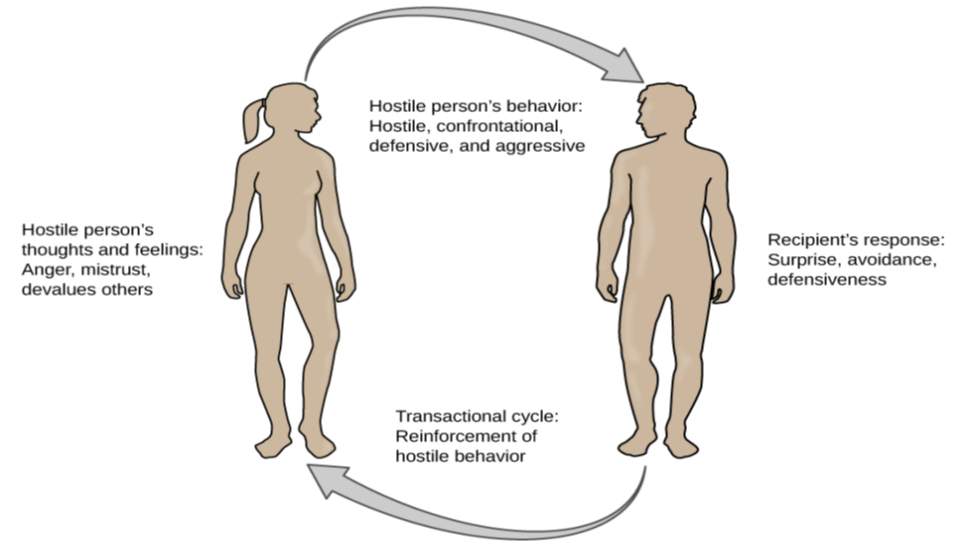
Socially, she is confrontational and tends to use a harsh tone with people, which often leads to very disagreeable and sometimes argumentative social interactions. As you might imagine, Kaitlin is not especially popular with others, including coworkers, neighbors, and even members of her own family. They either avoid her at all costs or snap back at her, which causes Kaitlin to become even more cynical and distrustful of others, making her disposition even more hostile. Kaitlin’s hostility—through her own doing—has created an antagonistic environment that cyclically causes her to become even more hostile and angry, thereby potentially setting the stage for cardiovascular problems.
In addition to anger and hostility, a number of other negative emotional states have been linked with heart disease, including negative affectivity and depression (Suls & Bunde, 2005). Negative affectivity is a tendency to experience distressed emotional states involving anger, contempt, disgust, guilt, fear, and nervousness (Watson, Clark, & Tellegen, 1988). It has been linked with the development of both hypertension and heart disease. For example, over 3,000 initially healthy participants in one study were tracked longitudinally, up to 22 years. Those with higher levels of negative affectivity at the time the study began were substantially more likely to develop and be treated for hypertension during the ensuing years than were those with lower levels of negative affectivity (Jonas & Lando, 2000). In addition, a study of over 10,000 middle-aged London-based civil servants who were followed an average of 12.5 years revealed that those who earlier had scored in the upper third on a test of negative affectivity were 32% more likely to have experienced heart disease, heart attack, or angina over a period of years than were those who scored in the lowest third (Nabi, Kivimaki, De Vogli, Marmot, & Singh-Manoux, 2008). Hence, negative affectivity appears to be a potentially vital risk factor for the development of cardiovascular disorders.
Depression and the Heart
For centuries, poets and folklore have asserted that there is a connection between moods and the heart (Glassman & Shapiro, 1998). You are no doubt familiar with the notion of a broken heart following a disappointing or depressing event and have encountered that notion in songs, films, and literature.
Perhaps the first to recognize the link between depression and heart disease was Benjamin Malzberg (1937), who found that the death rate among institutionalized patients with melancholia (an archaic term for depression) was six times higher than that of the population. A classic study in the late 1970s looked at over 8,000 people diagnosed with manic-depressive disorder (now classified as bipolar disorder) in Denmark, finding a nearly 50% increase in deaths from heart disease among these patients compared with the general Danish population (Weeke, 1979). By the early 1990s, evidence began to accumulate showing that depressed individuals who were followed for long periods of time were at increased risk for heart disease and cardiac death (Glassman, 2007). In one investigation of over 700 Denmark residents, those with the highest depression scores were 71% more likely to have experienced a heart attack than were those with lower depression scores (Barefoot & Schroll, 1996). Figure 14.20 illustrates the gradation in risk of heart attacks for both men and women.

- In one study, death rates from cardiovascular problems was substantially higher in depressed people; depressed men were 50% more likely to have died from cardiovascular problems, and depressed women were 70% more likely (Ösby, Brandt, Correia, Ekbom, & Sparén, 2001).
- A statistical review of 10 longitudinal studies involving initially healthy individuals revealed that those with elevated depressive symptoms have, on average, a 64% greater risk of developing heart disease than do those with fewer symptoms (Wulsin & Singal, 2003).
- A study of over 63,000 registered nurses found that those with more depressed symptoms when the study began were 49% more likely to experience fatal heart disease over a 12-year period (Whang et al., 2009).
The American Heart Association, fully aware of the established importance of depression in cardiovascular diseases, several years ago recommended routine depression screening for all heart disease patients (Lichtman et al., 2008). Recently, they have recommended including depression as a risk factor for heart disease patients (AHA, 2014).
Although the exact mechanisms through which depression might produce heart problems have not been fully clarified, a recent investigation examining this connection in early life has shed some light. In an ongoing study of childhood depression, adolescents who had been diagnosed with depression as children were more likely to be obese, smoke, and be physically inactive than were those who had not received this diagnosis (Rottenberg et al., 2014). One implication of this study is that depression, especially if it occurs early in life, may increase the likelihood of living an unhealthy lifestyle, thereby predisposing people to an unfavorable cardiovascular disease risk profile.
It is important to point out that depression may be just one piece of the emotional puzzle in elevating the risk for heart disease, and that chronically experiencing several negative emotional states may be especially important. A longitudinal investigation of Vietnam War veterans found that depression, anxiety, hostility, and trait anger each independently predicted the onset of heart disease (Boyle, Michalek, & Suarez, 2006). However, when each of these negative psychological attributes was combined into a single variable, this new variable (which researchers called psychological risk factor) predicted heart disease more strongly than any of the individual variables. Thus, rather than examining the predictive power of isolated psychological risk factors, it seems crucial for future researchers to examine the effects of combined and more general negative emotional and psychological traits in the development of cardiovascular illnesses.
Asthma
Asthma is a chronic and serious disease in which the airways of the respiratory system become obstructed, leading to great difficulty expelling air from the lungs. The airway obstruction is caused by inflammation of the airways (leading to thickening of the airway walls) and a tightening of the muscles around them, resulting in a narrowing of the airways (Figure 14.21) (American Lung Association, 2010). Because airways become obstructed, a person with asthma will sometimes have great difficulty breathing and will experience repeated episodes of wheezing, chest tightness, shortness of breath, and coughing, the latter occurring mostly during the morning and night (CDC, 2006).
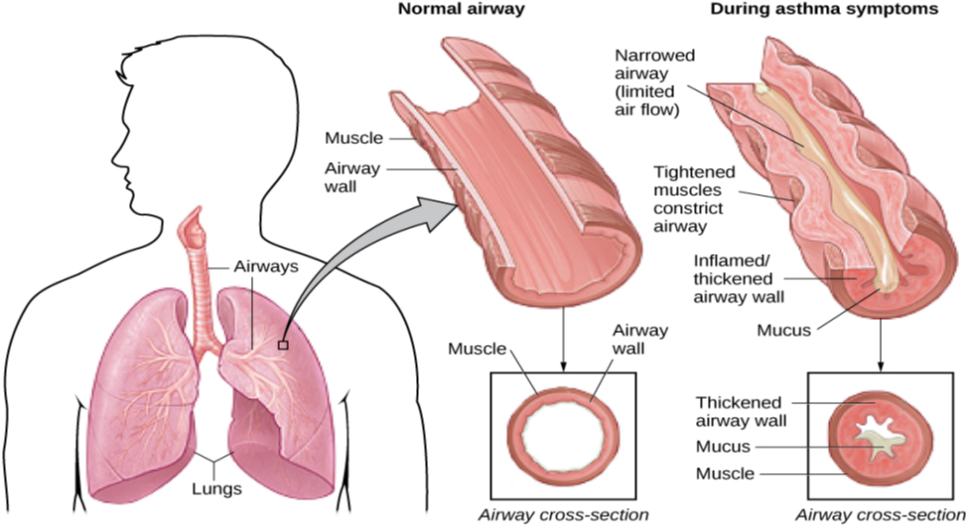
Asthma attacks are acute episodes in which an asthma sufferer experiences the full range of symptoms. Asthma exacerbation is often triggered by environmental factors, such as air pollution, allergens (e.g., pollen, mold, and pet hairs), cigarette smoke, airway infections, cold air or a sudden change in temperature, and exercise (CDC, 2013b).
Psychological factors appear to play an important role in asthma (Wright, Rodriguez, & Cohen, 1998), although some believe that psychological factors serve as potential triggers in only a subset of asthma patients (Ritz, Steptoe, Bobb, Harris, & Edwards, 2006). Many studies over the years have demonstrated that some people with asthma will experience asthma-like symptoms if they expect to experience such symptoms, such as when breathing an inert substance that they (falsely) believe will lead to airway obstruction (Sodergren & Hyland, 1999). As stress and emotions directly affect immune and respiratory functions, psychological factors likely serve as one of the most common triggers of asthma exacerbation (Trueba & Ritz, 2013).
People with asthma tend to report and display a high level of negative emotions such as anxiety, and asthma attacks have been linked to periods of high emotionality (Lehrer, Isenberg, & Hochron, 1993). In addition, high levels of emotional distress during both laboratory tasks and daily life have been found to negatively affect airway function and can produce asthma-like symptoms in people with asthma (von Leupoldt, Ehnes, & Dahme, 2006). In one investigation, 20 adults with asthma wore preprogrammed wristwatches that signaled them to breathe into a portable device that measures airway function. Results showed that higher levels of negative emotions and stress were associated with increased airway obstruction and self-reported asthma symptoms (Smyth, Soefer, Hurewitz, Kliment, & Stone, 1999). In addition, D’Amato, Liccardi, Cecchi, Pellegrino, & D’Amato (2010) described a case study of an 18-year-old man with asthma whose girlfriend had broken up with him, leaving him in a depressed state. She had also unfriended him on Facebook, while friending other young males. Eventually, the young man was able to “friend” her once again and could monitor her activity through Facebook. Subsequently, he would experience asthma symptoms whenever he logged on and accessed her profile. When he later resigned not to use Facebook any longer, the asthma attacks stopped. This case suggests that the use of Facebook and other forms of social media may represent a new source of stress—it may be a triggering factor for asthma attacks, especially in depressed asthmatic individuals.
Exposure to stressful experiences, particularly those that involve parental or interpersonal conflicts, has been linked to the development of asthma throughout the lifespan. A longitudinal study of 145 children found that parenting difficulties during the first year of life increased the chances that the child developed asthma by 107% (Klinnert et al., 2001). In addition, a cross-sectional study of over 10,000 Finnish college students found that high rates of parent or personal conflicts (e.g., parental divorce, separation from spouse, or severe conflicts in other long-term relationships) increased the risk of asthma onset (Kilpeläinen, Koskenvuo, Helenius, & Terho, 2002). Further, a study of over 4,000 middle-aged men who were interviewed in the early 1990s and again a decade later found that breaking off an important life partnership (e.g., divorce or breaking off relationship from parents) increased the risk of developing asthma by 124% over the time of the study (Loerbroks, Apfelbacher, Thayer, Debling, & Stürmer, 2009).
Headaches
A headache is a continuous pain anywhere in the head and neck region. Inflammation of the sinuses caused by an infection or allergic reaction can cause sinus headaches, which are experienced as pain in the cheeks and forehead. Migraine headaches are a type of headache thought to be caused by blood vessel swelling and increased blood flow (McIntosh, 2013). Migraines are characterized by severe pain on one or both sides of the head, an upset stomach, and disturbed vision. They are more frequently experienced by women than by men (American Academy of Neurology, 2014). Tension headaches are triggered by tightening/tensing of facial and neck muscles; they are the most commonly experienced kind of headache, accounting for about 42% of all headaches worldwide (Stovner et al., 2007). In the United States, well over one-third of the population experiences tension headaches each year, and 2–3% of the population suffers from chronic tension headaches (Schwartz, Stewart, Simon, & Lipton, 1998).
A number of factors can contribute to tension headaches, including sleep deprivation, skipping meals, eye strain, overexertion, muscular tension caused by poor posture, and stress (MedicineNet, 2013). Although there is uncertainty regarding the exact mechanisms through which stress can produce tension headaches, stress has been demonstrated to increase sensitivity to pain (Caceres & Burns, 1997; Logan et al., 2001). In general, tension headache sufferers, compared to non-sufferers, have a lower threshold for and greater sensitivity to pain (Ukestad & Wittrock, 1996), and they report greater levels of subjective stress when faced with a stressor (Myers, Wittrock, & Foreman, 1998). Thus, stress may contribute to tension headaches by increasing pain sensitivity in already-sensitive pain pathways in tension headache sufferers (Cathcart, Petkov, & Pritchard, 2008).
14.3 TEST YOURSELF
14.4 Regulation of Stress
LEARNING OBJECTIVES
By the end of this section, you will be able to:
- Define coping and differentiate between problem-focused and emotion-focused coping
- Describe the importance of perceived control in our reactions to stress
- Explain how social support is vital in health and longevity
As we learned in the previous section, stress—especially if it is chronic—takes a toll on our bodies and can have enormously negative health implications. When we experience events in our lives that we appraise as stressful, it is essential that we use effective coping strategies to manage our stress. Coping refers to mental and behavioral efforts that we use to deal with problems relating to stress.
Coping Styles
Lazarus and Folkman (1984) distinguished two fundamental kinds of coping: problem-focused coping and emotion-focused coping. In problem-focused coping, one attempts to manage or alter the problem that is causing one to experience stress (i.e., the stressor). Problem-focused coping strategies are similar to strategies used in everyday problem-solving: they typically involve identifying the problem, considering possible solutions, weighing the costs and benefits of these solutions, and then selecting an alternative (Lazarus & Folkman, 1984). As an example, suppose Bradford receives a midterm notice that he is failing statistics class. If Bradford adopts a problem-focused coping approach to managing his stress, he would be proactive in trying to alleviate the source of the stress. He might contact his professor to discuss what must be done to raise his grade, he might also decide to set aside two hours daily to study statistics assignments, and he may seek tutoring assistance. A problem-focused approach to managing stress means we actively try to do things to address the problem.
Emotion-focused coping, in contrast, consists of efforts to change or reduce the negative emotions associated with stress. These efforts may include avoiding, minimizing, or distancing oneself from the problem, or positive comparisons with others (“I’m not as bad off as she is”), or seeking something positive in a negative event (“Now that I’ve been fired, I can sleep in for a few days”). In some cases, emotion-focused coping strategies involve reappraisal, whereby the stressor is construed differently (and somewhat self-deceptively) without changing its objective level of threat (Lazarus & Folkman, 1984). For example, a person sentenced to federal prison who thinks, “This will give me a great chance to network with others,” is using reappraisal. If Bradford adopted an emotion-focused approach to managing his midterm deficiency stress, he might watch a comedy movie, play video games, or spend hours on social media to take his mind off the situation. In a certain sense, emotion-focused coping can be thought of as treating the symptoms rather than the actual cause.
While many stressors elicit both kinds of coping strategies, problem-focused coping is more likely to occur when encountering stressors we perceive as controllable, while emotion-focused coping is more likely to predominate when faced with stressors that we believe we are powerless to change (Folkman & Lazarus, 1980). Clearly, emotion-focused coping is more effective in dealing with uncontrollable stressors. For example, the stress you experience when a loved one dies can be overwhelming. You are simply powerless to change the situation as there is nothing you can do to bring this person back. The most helpful coping response is emotion-focused coping aimed at minimizing the pain of the grieving period.
Fortunately, most stressors we encounter can be modified and are, to varying degrees, controllable. A person who cannot stand her job can quit and look for work elsewhere; a middle-aged divorcee can find another potential partner; the freshman who fails an exam can study harder next time, and a breast lump does not necessarily mean that one is fated to die of breast cancer.
Control and Stress
The desire and ability to predict events, make decisions, and affect outcomes—that is, to enact control in our lives—is a basic tenet of human behavior (Everly & Lating, 2002). Albert Bandura (1997) stated that “the intensity and chronicity of human stress is governed largely by perceived control over the demands of one’s life” (p. 262). As cogently described in his statement, our reaction to potential stressors depends to a large extent on how much control we feel we have over such things. Perceived control is our beliefs about our personal capacity to exert influence over and shape outcomes, and it has major implications for our health and happiness (Infurna & Gerstorf, 2014). Extensive research has demonstrated that perceptions of personal control are associated with a variety of favorable outcomes, such as better physical and mental health and greater psychological well-being (Diehl & Hay, 2010). Greater personal control is also associated with lower reactivity to stressors in daily life. For example, researchers in one investigation found that higher levels of perceived control at one point in time were later associated with lower emotional and physical reactivity to interpersonal stressors (Neupert, Almeida, & Charles, 2007). Further, a daily diary study with 34 older widows found that their stress and anxiety levels were significantly reduced on days during which the widows felt greater perceived control (Ong, Bergeman, & Bisconti, 2005).
DIG DEEPER
Learned Helplessness
When we lack a sense of control over the events in our lives, particularly when those events are threatening, harmful, or noxious, the psychological consequences can be profound. In one of the better illustrations of this concept, psychologist Martin Seligman conducted a series of classic experiments in the 1960s (Seligman & Maier, 1967) in which dogs were placed in a chamber where they received electric shocks from which they could not escape. Later, when these dogs were given the opportunity to escape the shocks by jumping across a partition, most failed to even try; they seemed to just give up and passively accept any shocks the experimenters chose to administer. In comparison, dogs who were previously allowed to escape the shocks tended to jump the partition and escape the pain (Figure 14.22).

Seligman and colleagues later reformulated the original learned helplessness model of depression (Abramson, Seligman, & Teasdale, 1978). In their reformulation, they emphasized attributions (i.e., a mental explanation for why something occurred) that fostered a sense of learned helplessness. For example, suppose a coworker shows up late to work; your belief as to what caused the coworker’s tardiness would be an attribution (e.g., too much traffic, slept too late, or just doesn’t care about being on time).
The reformulated version of Seligman’s study holds that the attributions made for negative life events contribute to depression. Consider the example of a student who performs poorly on a midterm exam. This model suggests that the student will make three kinds of attributions for this outcome: internal vs. external (believing the outcome was caused by his own personal inadequacies or by environmental factors), stable vs. unstable (believing the cause can be changed or is permanent), and global vs. specific (believing the outcome is a sign of inadequacy in most everything versus just this area). Assume that the student makes an internal (“I’m just not smart”), stable (“Nothing can be done to change the fact that I’m not smart”) and global (“This is another example of how lousy I am at everything”) attribution for the poor performance. The reformulated theory predicts that the student would perceive a lack of control over this stressful event and thus be especially prone to developing depression. Indeed, research has demonstrated that people who have a tendency to make internal, global, and stable attributions for bad outcomes tend to develop symptoms of depression when faced with negative life experiences (Peterson & Seligman, 1984). Fortunately, attribution habits can be changed through practice. Training in healthy attribution habits has been shown to make people less vulnerable to depression (Konnikova, 2015).
Seligman’s learned helplessness model has emerged over the years as a leading theoretical explanation for the onset of major depressive disorder. When you study psychological disorders, you will learn more about the latest reformulation of this model—now called hopelessness theory.
People who report higher levels of perceived control view their health as controllable, thereby making it more likely that they will better manage their health and engage in behaviors conducive to good health (Bandura, 2004). Not surprisingly, greater perceived control has been linked to lower risk of physical health problems, including declines in physical functioning (Infurna, Gerstorf, Ram, Schupp, & Wagner, 2011), heart attacks (Rosengren et al., 2004), and both cardiovascular disease incidence (Stürmer, Hasselbach, & Amelang, 2006) and mortality from cardiac disease (Surtees et al., 2010). In addition, longitudinal studies of British civil servants have found that those in low-status jobs (e.g., clerical and office support staff) in which the degree of control over the job is minimal are considerably more likely to develop heart disease than those with high-status jobs or considerable control over their jobs (Marmot, Bosma, Hemingway, & Stansfeld, 1997).
The link between perceived control and health may provide an explanation for the frequently observed relationship between social class and health outcomes (Kraus, Piff, Mendoza-Denton, Rheinschmidt, & Keltner, 2012). In general, research has found that more affluent individuals experience better health partly because they tend to believe that they can personally control and manage their reactions to life’s stressors (Johnson & Krueger, 2006). Perhaps buoyed by the perceived level of control, individuals of higher social class may be prone to overestimating the degree of influence they have over particular outcomes. For example, those of higher social class tend to believe that their votes have greater sway on election outcomes than do those of lower social class, which may explain higher rates of voting in more affluent communities (Krosnick, 1990). Other research has found that a sense of perceived control can protect less affluent individuals from poorer health, depression, and reduced life-satisfaction—all of which tend to accompany lower social standing (Lachman & Weaver, 1998).
Taken together, findings from these and many other studies clearly suggest that perceptions of control and coping abilities are important in managing and coping with the stressors we encounter throughout life.
Social Support
The need to form and maintain strong, stable relationships with others is a powerful, pervasive, and fundamental human motive (Baumeister & Leary, 1995). Building strong interpersonal relationships with others helps us establish a network of close, caring individuals who can provide social support in times of distress, sorrow, and fear. Social support can be thought of as the soothing impact of friends, family, and acquaintances (Baron & Kerr, 2003). Social support can take many forms, including advice, guidance, encouragement, acceptance, emotional comfort, and tangible assistance (such as financial help). Thus, other people can be very comforting to us when we are faced with a wide range of life stressors, and they can be extremely helpful in our efforts to manage these challenges. Even in nonhuman animals, species mates can offer social support during times of stress. For example, elephants seem to be able to sense when other elephants are stressed and will often comfort them with physical contact—such as a trunk touch—or an empathetic vocal response (Krumboltz, 2014).
Scientific interest in the importance of social support first emerged in the 1970s when health researchers developed an interest in the health consequences of being socially integrated (Stroebe & Stroebe, 1996). Interest was further fueled by longitudinal studies showing that social connectedness reduced mortality. In one classic study, nearly 7,000 Alameda County, California, residents were followed over 9 years. Those who had previously indicated that they lacked social and community ties were more likely to die during the follow-up period than those with more extensive social networks. Compared to those with the most social contacts, isolated men and women were, respectively, 2.3 and 2.8 times more likely to die. These trends persisted even after controlling for a variety of health-related variables, such as smoking, alcohol consumption, self-reported health at the beginning of the study, and physical activity (Berkman & Syme, 1979).
Since the time of that study, social support has emerged as one of the well-documented psychosocial factors affecting health outcomes (Uchino, 2009). A statistical review of 148 studies conducted between 1982 and 2007 involving over 300,000 participants concluded that individuals with stronger social relationships have a 50% greater likelihood of survival compared to those with weak or insufficient social relationships (Holt-Lunstad, Smith, & Layton, 2010). According to the researchers, the magnitude of the effect of social support observed in this study is comparable with quitting smoking and exceeded many well-known risk factors for mortality, such as obesity and physical inactivity (Figure 14.23).

For many of us, friends are a vital source of social support. But what if you find yourself in a situation in which you have few friends and companions? Many students who leave home to attend and live at college experience drastic reductions in their social support, which makes them vulnerable to anxiety, depression, and loneliness. Social media can sometimes be useful in navigating these transitions (Raney & Troop Gordon, 2012) but might also cause increases in loneliness (Hunt, Marx, Lipson, & Young, 2018). For this reason, many colleges have designed first-year programs, such as peer mentoring (Raymond & Shepard, 2018), that can help students build new social networks. For some people, our families—especially our parents—are a major source of social support.
Social support appears to work by boosting the immune system, especially among people who are experiencing stress (Uchino, Vaughn, Carlisle, & Birmingham, 2012). In a pioneering study, spouses of cancer patients who reported high levels of social support showed indications of better immune functioning on two out of three immune functioning measures, compared to spouses who were below the median on reported social support (Baron, Cutrona, Hicklin, Russell, & Lubaroff, 1990). Studies of other populations have produced similar results, including those of spousal caregivers of dementia sufferers, medical students, elderly adults, and cancer patients (Cohen & Herbert, 1996; Kiecolt-Glaser, McGuire, Robles, & Glaser, 2002).
In addition, social support has been shown to reduce blood pressure for people performing stressful tasks, such as giving a speech or performing mental arithmetic (Lepore, 1998). In these kinds of studies, participants are usually asked to perform a stressful task either alone, with a stranger present (who may be either supportive or unsupportive), or with a friend present. Those tested with a friend present generally exhibit lower blood pressure than those tested alone or with a stranger (Fontana, Diegnan, Villeneuve, & Lepore, 1999). In one study, 112 female participants who performed stressful mental arithmetic exhibited lower blood pressure when they received support from a friend rather than a stranger, but only if the friend was a male (Phillips, Gallagher, & Carroll, 2009). Although these findings are somewhat difficult to interpret, the authors mention that it is possible that females feel less supported and more evaluated by other females, particularly females whose opinions they value.
Taken together, the findings above suggest one of the reasons social support is connected to favorable health outcomes is because it has several beneficial physiological effects in stressful situations. However, it is also important to consider the possibility that social support may lead to better health behaviors, such as a healthy diet, exercising, smoking cessation, and cooperation with medical regimens (Uchino, 2009).
DIG DEEPER
Stress and Discrimination
Being the recipient of prejudice and discrimination is associated with a number of negative outcomes. Many studies have shown how perceived discrimination is a significant stressor for marginalized groups (Pascoe & Smart Richman, 2009). Discrimination negatively impacts both physical and mental health for individuals in stigmatized groups. As you’ll learn when you study social psychology, various social identities (such as gender, age, religion, sexuality, ethnicity) often lead people to simultaneously be exposed to multiple forms of discrimination, which can have even stronger negative effects on mental and physical health (Vines, Ward, Cordoba, & Black, 2017). For example, the amplified levels of discrimination faced by Latinx transgender women may have related effects, leading to high stress levels and poor mental and physical health outcomes.
Perceived control and the general adaptation syndrome help explain the process by which discrimination affects mental and physical health. Discrimination can be conceptualized as an uncontrollable, persistent, and unpredictable stressor. When a discriminatory event occurs, the target of the event initially experiences an acute stress response (alarm stage). This acute reaction alone does not typically have a great impact on health. However, discrimination tends to be a chronic stressor. As people in marginalized groups experience repeated discrimination, they develop a heightened reactivity as their bodies prepare to act quickly (resistance stage). This long-term accumulation of stress responses can eventually lead to increases in negative emotion and wear on physical health (exhaustion stage). This explains why a history of perceived discrimination is associated with a host of mental and physical health problems including depression, cardiovascular disease, and cancer (Pascoe & Smart Richman, 2009).
Protecting stigmatized groups from the negative impact of discrimination-induced stress may involve reducing the incidence of discriminatory behaviors in conjunction with protective strategies that reduce the impact of discriminatory events when they occur. Civil rights legislation has protected some stigmatized groups by making discrimination a prosecutable offense in many social contexts. However, some groups (e.g., transgender people) often lack important legal recourse when discrimination occurs. Moreover, most modern discrimination comes in subtle forms that fall below the radar of the law. For example, discrimination may be experienced as selective inhospitality that the target perceives as race-based discrimination, but little is done in response since it would be easy to attribute the behavior to other causes. Although some cultural changes are increasingly helping people to recognize and control subtle discrimination, such shifts may take a long time.
Similar to other stressors, buffers like social support and healthy coping strategies appear to be effective in lowering the impact of perceived discrimination. For example, one study (Ajrouch, Reisine, Lim, Sohn, & Ismail, 2010) showed that discrimination predicted high psychological distress among African American mothers living in Detroit. However, the women who had readily available emotional support from friends and family experienced less distress than those with fewer social resources. While coping strategies and social support may buffer the effects of discrimination, they fail to erase all of the negative impacts. Vigilant antidiscrimination efforts, including the development of legal protections for vulnerable groups, are needed to reduce discrimination, stress, and the resulting physical and mental health effects.
Stress Reduction Techniques
Beyond having a sense of control and establishing social support networks, there are numerous other means by which we can manage stress (Figure 14.24). A common technique people use to combat stress is exercise (Salmon, 2001). It is well-established that exercise, both of long (aerobic) and short (anaerobic) duration, is beneficial for both physical and mental health (Everly & Lating, 2002). There is considerable evidence that physically fit individuals are more resistant to the adverse effects of stress and recover more quickly from stress than less physically fit individuals (Cotton, 1990). In a study of more than 500 Swiss police officers and emergency service personnel, increased physical fitness was associated with reduced stress, and regular exercise was reported to protect against stress-related health problems (Gerber, Kellman, Hartman, & Pühse, 2010).

In the 1970s, Herbert Benson, a cardiologist, developed a stress reduction method called the relaxation response technique (Greenberg, 2006). The relaxation response technique combines relaxation with transcendental meditation, and consists of four components (Stein, 2001):
- sitting upright on a comfortable chair with feet on the ground and body in a relaxed position,
- being in a quiet environment with eyes closed,
- repeating a word or a phrase—a mantra—to oneself, such as “alert mind, calm body,”
- passively allowing the mind to focus on pleasant thoughts, such as nature or the warmth of your blood nourishing your body.
The relaxation response approach is conceptualized as a general approach to stress reduction that reduces sympathetic arousal, and it has been used effectively to treat people with high blood pressure (Benson & Proctor, 1994).
Another technique to combat stress, biofeedback, was developed by Gary Schwartz at Harvard University in the early 1970s. Biofeedback is a technique that uses electronic equipment to accurately measure a person’s neuromuscular and autonomic activity—feedback is provided in the form of visual or auditory signals. The main assumption of this approach is that providing somebody biofeedback will enable the individual to develop strategies that help gain some level of voluntary control over what are normally involuntary bodily processes (Schwartz & Schwartz, 1995). A number of different bodily measures have been used in biofeedback research, including facial muscle movement, brain activity, and skin temperature, and it has been applied successfully with individuals experiencing tension headaches, high blood pressure, asthma, and phobias (Stein, 2001).
14.4 TEST YOURSELF
14.5 The Pursuit of Happiness
LEARNING OBJECTIVES
By the end of this section, you will be able to:
- Define and discuss happiness, including its determinants
- Describe the field of positive psychology and identify the kinds of problems it addresses
- Explain the meaning of positive affect and discuss its importance in health outcomes
- Describe the concept of flow and its relationship to happiness and fulfillment
Although the study of stress and how it affects us physically and psychologically is fascinating, it is—admittedly—somewhat of a grim topic. Psychology is also interested in the study of a more upbeat and encouraging approach to human affairs—the quest for happiness.
Happiness
America’s founders declared that its citizens have an unalienable right to pursue happiness. But what is happiness? When asked to define the term, people emphasize different aspects of this elusive state. Indeed, happiness is somewhat ambiguous and can be defined from different perspectives (Martin, 2012). Some people, especially those who are highly committed to their religious faith, view happiness in ways that emphasize virtuosity, reverence, and enlightened spirituality. Others see happiness as primarily contentment—the inner peace and joy that come from deep satisfaction with one’s surroundings, relationships with others, accomplishments, and oneself. Still others view happiness mainly as pleasurable engagement with their personal environment—having a career and hobbies that are engaging, meaningful, rewarding, and exciting. These differences, of course, are merely differences in emphasis. Most people would probably agree that each of these views, in some respects, captures the essence of happiness.
Elements of Happiness
Some psychologists have suggested that happiness consists of three distinct elements: the pleasant life, the good life, and the meaningful life, as shown in Figure 14.25 (Seligman, 2002; Seligman, Steen, Park, & Peterson, 2005). The pleasant life is realized through the attainment of day-to-day pleasures that add fun, joy, and excitement to our lives. For example, evening walks along the beach and a fulfilling sex life can enhance our daily pleasure and contribute to the pleasant life. The good life is achieved through identifying our unique skills and abilities and engaging these talents to enrich our lives; those who achieve the good life often find themselves absorbed in their work or their recreational pursuits. The meaningful life involves a deep sense of fulfillment that comes from using our talents in the service of the greater good: in ways that benefit the lives of others or that make the world a better place. In general, the happiest people tend to be those who pursue the full life—they orient their pursuits toward all three elements (Seligman et al., 2005).
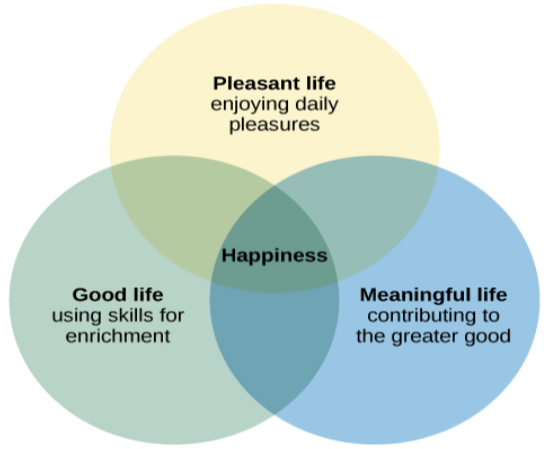
The study of happiness has grown dramatically in the last three decades (Diener, 2013). One of the most basic questions that happiness investigators routinely examine is this: How happy are people in general? The average person in the world tends to be relatively happy and tends to indicate experiencing more positive feelings than negative feelings (Diener, Ng, Harter, & Arora, 2010). When asked to evaluate their current lives on a scale ranging from 0 to 10 (with 0 representing “worst possible life” and 10 representing “best possible life”), people in more than 150 countries surveyed from 2010–2012 reported an average score of 5.2. People who live in North America, Australia, and New Zealand reported the highest average score at 7.1, whereas those living Sub-Saharan Africa reported the lowest average score at 4.6 (Helliwell, Layard, & Sachs, 2013). Worldwide, the five happiest countries are Denmark, Norway, Switzerland, the Netherlands, and Sweden; the United States is ranked 17th happiest (Figure 14.26) (Helliwell et al., 2013).

Factors Connected to Happiness
What really makes people happy? What factors contribute to sustained joy and contentment? Is it money, attractiveness, material possessions, a rewarding occupation, a satisfying relationship? Extensive research over the years has examined this question. One finding is that age is related to happiness: Life satisfaction usually increases the older people get, but there do not appear to be gender differences in happiness (Diener, Suh, Lucas, & Smith, 1999). Although it is important to point out that much of this work has been correlational, many of the key findings (some of which may surprise you) are summarized below.
Family and other social relationships appear to be key factors correlated with happiness. Studies show that married people report being happier than those who are single, divorced, or widowed (Diener et al., 1999). Happy individuals also report that their marriages are fulfilling (Lyubomirsky, King, & Diener, 2005). In fact, some have suggested that satisfaction with marriage and family life is the strongest predictor of happiness (Myers, 2000). Happy people tend to have more friends, more high-quality social relationships, and stronger social support networks than less happy people (Lyubomirsky et al., 2005). Happy people also have a high frequency of contact with friends (Pinquart & Sörensen, 2000).
Can money buy happiness? In general, extensive research suggests that the answer is yes, but with several caveats. While a nation’s per capita gross domestic product (GDP) is associated with happiness levels (Helliwell et al., 2013), changes in GDP (which is a less certain index of household income) bear little relationship to changes in happiness (Diener, Tay, & Oishi, 2013). On the whole, residents of affluent countries tend to be happier than residents of poor countries; within countries, wealthy individuals are happier than poor individuals, but the association is much weaker (Diener & Biswas-Diener, 2002). To the extent that it leads to increases in purchasing power, increases in income are associated with increases in happiness (Diener, Oishi, & Ryan, 2013). However, income within societies appears to correlate with happiness only up to a point. In a study of over 450,000 U.S. residents surveyed by the Gallup Organization, Kahneman and Deaton (2010) found that well-being rises with annual income, but only up to $75,000. The average increase in reported well-being for people with incomes greater than $75,000 was null. As implausible as these findings might seem—after all, higher incomes would enable people to indulge in Hawaiian vacations, prime seats as sporting events, expensive automobiles, and expansive new homes—higher incomes may impair people’s ability to savor and enjoy the small pleasures of life (Kahneman, 2011). Indeed, researchers in one study found that participants exposed to a subliminal reminder of wealth spent less time savoring a chocolate candy bar and exhibited less enjoyment of this experience than did participants who were not reminded of wealth (Quoidbach, Dunn, Petrides, & Mikolajczak, 2010).
What about education and employment? Happy people, compared to those who are less happy, are more likely to graduate from college and secure more meaningful and engaging jobs. Once they obtain a job, they are also more likely to succeed (Lyubomirsky et al., 2005). While education shows a positive (but weak) correlation with happiness, intelligence is not appreciably related to happiness (Diener et al., 1999).
Does religiosity correlate with happiness? In general, the answer is yes (Hackney & Sanders, 2003). However, the relationship between religiosity and happiness depends on societal circumstances. Nations and states with more difficult living conditions (e.g., widespread hunger and low life expectancy) tend to be more highly religious than societies with more favorable living conditions. Among those who live in nations with difficult living conditions, religiosity is associated with greater well-being; in nations with more favorable living conditions, religious and nonreligious individuals report similar levels of well-being (Diener, Tay, & Myers, 2011).
Clearly the living conditions of one’s nation can influence factors related to happiness. What about the influence of one’s culture? To the extent that people possess characteristics that are highly valued by their culture, they tend to be happier (Diener, 2012). For example, self-esteem is a stronger predictor of life satisfaction in individualistic cultures than in collectivistic cultures (Diener, Diener, & Diener, 1995), and extraverted people tend to be happier in extraverted cultures than in introverted cultures (Fulmer et al., 2010).
So we’ve identified many factors that exhibit some correlation to happiness. What factors don’t show a correlation? Researchers have studied both parenthood and physical attractiveness as potential contributors to happiness, but no link has been identified. Although people tend to believe that parenthood is central to a meaningful and fulfilling life, aggregate findings from a range of countries indicate that people who do not have children are generally happier than those who do (Hansen, 2012). And although one’s perceived level of attractiveness seems to predict happiness, a person’s objective physical attractiveness is only weakly correlated with her happiness (Diener, Wolsic, & Fujita, 1995).
Life Events and Happiness
An important point should be considered regarding happiness. People are often poor at affective forecasting: predicting the intensity and duration of their future emotions (Wilson & Gilbert, 2003). In one study, nearly all newlywed spouses predicted their marital satisfaction would remain stable or improve over the following four years; despite this high level of initial optimism, their marital satisfaction actually declined during this period (Lavner, Karner, & Bradbury, 2013). In addition, we are often incorrect when estimating how our long-term happiness would change for the better or worse in response to certain life events. For example, it is easy for many of us to imagine how euphoric we would feel if we won the lottery, were asked on a date by an attractive celebrity, or were offered our dream job. It is also easy to understand how long-suffering fans of the Chicago Cubs baseball team, which had not won a World Series championship since 1908, thought they would feel permanently elated when their team finally won another World Series in 2016. Likewise, it is easy to predict that we would feel permanently miserable if we suffered a disabling accident or if a romantic relationship ended.
However, something similar to sensory adaptation often occurs when people experience emotional reactions to life events. In much the same way our senses adapt to changes in stimulation (e.g., our eyes adapting to bright light after walking out of the darkness of a movie theater into the bright afternoon sun), we eventually adapt to changing emotional circumstances in our lives (Brickman & Campbell, 1971; Helson, 1964). When an event that provokes positive or negative emotions occurs, at first we tend to experience its emotional impact at full intensity. We feel a burst of pleasure following such things as a marriage proposal, birth of a child, acceptance to law school, an inheritance, and the like; as you might imagine, lottery winners experience a surge of happiness after hitting the jackpot (Lutter, 2007). Likewise, we experience a surge of misery following widowhood, a divorce, or a layoff from work. In the long run, however, we eventually adjust to the emotional new normal; the emotional impact of the event tends to erode, and we eventually revert to our original baseline happiness levels. Thus, what was at first a thrilling lottery windfall or World Series championship eventually loses its luster and becomes the status quo (Figure 14.27). Indeed, dramatic life events have much less long-lasting impact on happiness than might be expected (Brickman, Coats, & Janoff-Bulman, 1978).


Increasing Happiness
Some recent findings about happiness provide an optimistic picture, suggesting that real changes in happiness are possible. For example, thoughtfully developed well-being interventions designed to augment people’s baseline levels of happiness may increase happiness in ways that are permanent and long-lasting, not just temporary. These changes in happiness may be targeted at individual, organizational, and societal levels (Diener et al., 2006). Researchers in one study found that a series of happiness interventions involving such exercises as writing down three good things that occurred each day led to increases in happiness that lasted over six months (Seligman et al., 2005).
Measuring happiness and well-being at the societal level over time may assist policy makers in determining if people are generally happy or miserable, as well as when and why they might feel the way they do. Studies show that average national happiness scores (over time and across countries) relate strongly to six key variables: per capita gross domestic product (GDP, which reflects a nation’s economic standard of living), social support, freedom to make important life choices, healthy life expectancy, freedom from perceived corruption in government and business, and generosity (Helliwell et al., 2013). Investigating why people are happy or unhappy might help policymakers develop programs that increase happiness and well-being within a society (Diener et al., 2006). Resolutions about contemporary political and social issues that are frequent topics of debate—such as poverty, taxation, affordable health care and housing, clean air and water, and income inequality—might be best considered with people’s happiness in mind.
Positive Psychology
In 1998, Seligman (the same person who conducted the learned helplessness experiments mentioned earlier), who was then president of the American Psychological Association, urged psychologists to focus more on understanding how to build human strength and psychological well-being. In deliberately setting out to create a new direction and new orientation for psychology, Seligman helped establish a growing movement and field of research called positive psychology (Compton, 2005). In a very general sense, positive psychology can be thought of as the science of happiness; it is an area of study that seeks to identify and promote those qualities that lead to greater fulfillment in our lives. This field looks at people’s strengths and what helps individuals to lead happy, contented lives, and it moves away from focusing on people’s pathology, faults, and problems. According to Seligman and Csikszentmihalyi (2000), positive psychology,
at the subjective level is about valued subjective experiences: well-being, contentment, and satisfaction (in the past); hope and optimism (for the future); and… happiness (in the present). At the individual level, it is about positive individual traits: the capacity for love and vocation, courage, interpersonal skill, aesthetic sensibility, perseverance, forgiveness, originality, future mindedness, spirituality, high talent, and wisdom. (p. 5)
Some of the topics studied by positive psychologists include altruism and empathy, creativity, forgiveness and compassion, the importance of positive emotions, enhancement of immune system functioning, savoring the fleeting moments of life, and strengthening virtues as a way to increase authentic happiness (Compton, 2005). Recent efforts in the field of positive psychology have focused on extending its principles toward peace and well-being at the level of the global community. In a war-torn world in which conflict, hatred, and distrust are common, such an extended “positive peace psychology” could have important implications for understanding how to overcome oppression and work toward global peace (Cohrs, Christie, White, & Das, 2013).
DIG DEEPER
The Center for Investigating Healthy Minds
On the campus of the University of Wisconsin–Madison, the Center for Investigating Healthy Minds at the Waisman Center conducts rigorous scientific research on healthy aspects of the mind, such as kindness, forgiveness, compassion, and mindfulness. Established in 2008 and led by renowned neuroscientist Dr. Richard J. Davidson, the Center examines a wide range of ideas, including such things as a kindness curriculum in schools, neural correlates of prosocial behavior, psychological effects of Tai Chi training, digital games to foster prosocial behavior in children, and the effectiveness of yoga and breathing exercises in reducing symptoms of post-traumatic stress disorder.
According to its website, the Center was founded after Dr. Davidson was challenged by His Holiness, the 14th Dalai Lama, “to apply the rigors of science to study positive qualities of mind” (Center for Investigating Health Minds, 2013). The Center continues to conduct scientific research with the aim of developing mental health training approaches that help people to live happier, healthier lives.
Positive Affect and Optimism
Taking a cue from positive psychology, extensive research over the last 10-15 years has examined the importance of positive psychological attributes in physical well-being. Qualities that help promote psychological well-being (e.g., having meaning and purpose in life, a sense of autonomy, positive emotions, and satisfaction with life) are linked with a range of favorable health outcomes (especially improved cardiovascular health) mainly through their relationships with biological functions and health behaviors (such as diet, physical activity, and sleep quality) (Boehm & Kubzansky, 2012). The quality that has received attention is positive affect, which refers to pleasurable engagement with the environment, such as happiness, joy, enthusiasm, alertness, and excitement (Watson, Clark, & Tellegen, 1988). The characteristics of positive affect, as with negative affect (discussed earlier), can be brief, long-lasting, or trait-like (Pressman & Cohen, 2005). Independent of age, gender, and income, positive affect is associated with greater social connectedness, emotional and practical support, adaptive coping efforts, and lower depression; it is also associated with longevity and favorable physiological functioning (Steptoe, O’Donnell, Marmot, & Wardle, 2008).
Positive affect also serves as a protective factor against heart disease. In a 10-year study of Nova Scotians, the rate of heart disease was 22% lower for each one-point increase on the measure of positive affect, from 1 (no positive affect expressed) to 5 (extreme positive affect) (Davidson, Mostofsky, & Whang, 2010). In terms of our health, the expression, “don’t worry, be happy” is helpful advice indeed. There has also been much work suggesting that optimism—the general tendency to look on the bright side of things—is also a significant predictor of positive health outcomes.
Although positive affect and optimism are related in some ways, they are not the same (Pressman & Cohen, 2005). Whereas positive affect is mostly concerned with positive feeling states, optimism has been regarded as a generalized tendency to expect that good things will happen (Chang, 2001). It has also been conceptualized as a tendency to view life’s stressors and difficulties as temporary and external to oneself (Peterson & Steen, 2002). Numerous studies over the years have consistently shown that optimism is linked to longevity, healthier behaviors, fewer postsurgical complications, better immune functioning among men with prostate cancer, and better treatment adherence (Rasmussen & Wallio, 2008). Further, optimistic people report fewer physical symptoms, less pain, better physical functioning, and are less likely to be rehospitalized following heart surgery (Rasmussen, Scheier, & Greenhouse, 2009).
Flow
Another factor that seems to be important in fostering a deep sense of well-being is the ability to derive flow from the things we do in life. Flow is described as a particular experience that is so engaging and engrossing that it becomes worth doing for its own sake (Csikszentmihalyi, 1997). It is usually related to creative endeavors and leisure activities, but it can also be experienced by workers who like their jobs or students who love studying (Csikszentmihalyi, 1999). Many of us instantly recognize the notion of flow. In fact, the term derived from respondents’ spontaneous use of the term when asked to describe how it felt when what they were doing was going well. When people experience flow, they become involved in an activity to the point where they feel they lose themselves in the activity. They effortlessly maintain their concentration and focus, they feel as though they have complete control of their actions, and time seems to pass more quickly than usual (Csikszentmihalyi, 1997). Flow is considered a pleasurable experience, and it typically occurs when people are engaged in challenging activities that require skills and knowledge they know they possess. For example, people would be more likely report flow experiences in relation to their work or hobbies than in relation to eating. When asked the question, “Do you ever get involved in something so deeply that nothing else seems to matter, and you lose track of time?” about 20% of Americans and Europeans report having these flow-like experiences regularly (Csikszentmihalyi, 1997).
Although wealth and material possessions are nice to have, the notion of flow suggests that neither are prerequisites for a happy and fulfilling life. Finding an activity that you are truly enthusiastic about, something so absorbing that doing it is reward itself (whether it be playing tennis, studying Arabic, writing children’s novels, or cooking lavish meals) is perhaps the real key. According to Csikszentmihalyi (1999), creating conditions that make flow experiences possible should be a top social and political priority. How might this goal be achieved? How might flow be promoted in school systems? In the workplace? What potential benefits might be accrued from such efforts?
In an ideal world, scientific research endeavors should inform us on how to bring about a better world for all people. The field of positive psychology promises to be instrumental in helping us understand what truly builds hope, optimism, happiness, healthy relationships, flow, and genuine personal fulfillment.
14.5 TEST YOURSELF
Summary
14.1 What is Stress?
Stress is a process whereby an individual perceives and responds to events appraised as overwhelming or threatening to one’s well-being. The scientific study of how stress and emotional factors impact health and well-being is called health psychology, a field devoted to studying the general impact of psychological factors on health. The body’s primary physiological response during stress, the fight-or-flight response, was first identified in the early 20th century by Walter Cannon. The fight-or-flight response involves the coordinated activity of both the sympathetic nervous system and the hypothalamic-pituitary-adrenal (HPA) axis. Hans Selye, a noted endocrinologist, referred to these physiological reactions to stress as part of general adaptation syndrome, which occurs in three stages: alarm reaction (fight-or-flight reactions begin), resistance (the body begins to adapt to continuing stress), and exhaustion (adaptive energy is depleted, and stress begins to take a physical toll).
14.2 Stressors
Stressors can be chronic (long term) or acute (short term), and can include traumatic events, significant life changes, daily hassles, and situations in which people are frequently exposed to challenging and unpleasant events. Many potential stressors include events or situations that require us to make changes in our lives, such as a divorce or moving to a new residence. Thomas Holmes and Richard Rahe developed the Social Readjustment Rating Scale (SRRS) to measure stress by assigning a number of life change units to life events that typically require some adjustment, including positive events. Although the SRRS has been criticized on a number of grounds, extensive research has shown that the accumulation of many LCUs is associated with increased risk of illness. Many potential stressors also include daily hassles, which are minor irritations and annoyances that can build up over time. In addition, jobs that are especially demanding, offer little control over one’s working environment, or involve unfavorable working conditions can lead to job strain, thereby setting the stage for job burnout.
14.3 Stress and Illness
Psychophysiological disorders are physical diseases that are either brought about or worsened by stress and other emotional factors. One of the mechanisms through which stress and emotional factors can influence the development of these diseases is by adversely affecting the body’s immune system. A number of studies have demonstrated that stress weakens the functioning of the immune system. Cardiovascular disorders are serious medical conditions that have been consistently shown to be influenced by stress and negative emotions, such as anger, negative affectivity, and depression. Other psychophysiological disorders that are known to be influenced by stress and emotional factors include asthma and tension headaches.
14.4 Regulation of Stress
When faced with stress, people must attempt to manage or cope with it. In general, there are two basic forms of coping: problem-focused coping and emotion-focused coping. Those who use problem-focused coping strategies tend to cope better with stress because these strategies address the source of stress rather than the resulting symptoms. To a large extent, perceived control greatly impacts reaction to stressors and is associated with greater physical and mental well-being. Social support has been demonstrated to be a highly effective buffer against the adverse effects of stress. Extensive research has shown that social support has beneficial physiological effects for people, and it seems to influence immune functioning. However, the beneficial effects of social support may be related to its influence on promoting healthy behaviors.
14.5 The Pursuit of Happiness
Happiness is conceptualized as an enduring state of mind that consists of the capacity to experience pleasure in daily life, as well as the ability to engage one’s skills and talents to enrich one’s life and the lives of others. Although people around the world generally report that they are happy, there are differences in average happiness levels across nations. Although people have a tendency to overestimate the extent to which their happiness set points would change for the better or for the worse following certain life events, researchers have identified a number of factors that are consistently related to happiness. In recent years, positive psychology has emerged as an area of study seeking to identify and promote qualities that lead to greater happiness and fulfillment in our lives. These components include positive affect, optimism, and flow.
Critical Thinking Questions
- Provide an example (other than the one described earlier) of a situation or event that could be appraised as either threatening or challenging.
- Provide an example of a stressful situation that may cause a person to become seriously ill. How would Selye’s general adaptation syndrome explain this occurrence?
- Review the items on the Social Readjustment Rating Scale. Select one of the items and discuss how it might bring about distress and eustress.
- Job burnout tends to be high in people who work in human service jobs. Considering the three dimensions of job burnout, explain how various job aspects unique to being a police officer might lead to job burnout in that line of work.
- Discuss the concept of Type A behavior pattern, its history, and what we now know concerning its role in heart disease.
- Consider the study in which volunteers were given nasal drops containing the cold virus to examine the relationship between stress and immune function (Cohen et al., 1998). How might this finding explain how people seem to become sick during stressful times in their lives (e.g., final exam week)?
- Although problem-focused coping seems to be a more effective strategy when dealing with stressors, do you think there are any kinds of stressful situations in which emotion-focused coping might be a better strategy?
- Describe how social support can affect health both directly and indirectly.
- In considering the three dimensions of happiness discussed in this section (the pleasant life, the good life, and the meaningful life), what are some steps you could take to improve your personal level of happiness?
- The day before the drawing of a $300 million Powerball lottery, you notice that a line of people waiting to buy their Powerball tickets is stretched outside the door of a nearby convenience store. Based on what you’ve learned, provide some perspective on why these people are doing this, and what would likely happen if one of these individuals happened to pick the right numbers.
Personal Application Questions
- Think of a time in which you and others you know (family members, friends, and classmates) experienced an event that some viewed as threatening and others viewed as challenging. What were some of the differences in the reactions of those who experienced the event as threatening compared to those who viewed the event as challenging? Why do you think there were differences in how these individuals judged the same event?
- Suppose you want to design a study to examine the relationship between stress and illness, but you cannot use the Social Readjustment Rating Scale. How would you go about measuring stress? How would you measure illness? What would you need to do in order to tell if there is a cause-effect relationship between stress and illness?
- If a family member or friend of yours has asthma, talk to that person (if they are willing) about their symptom triggers. Does this person mention stress or emotional states? If so, are there any commonalities in these asthma triggers?
- Try to think of an example in which you coped with a particular stressor by using problem-focused coping. What was the stressor? What did your problem-focused efforts involve? Were they effective?
- Think of an activity you participate in that you find engaging and absorbing. For example, this might be something like playing video games, reading, or a hobby. What are your experiences typically like while engaging in this activity? Do your experiences conform to the notion of flow? If so, how? Do you think these experiences have enriched your life? Why or why not?
process whereby an individual perceives and responds to events that one appraises as overwhelming or threatening to one’s well-being
environmental events that may be judged as threatening or demanding; stimuli that initiate the stress process
judgment about the degree of potential harm or threat to well-being that a stressor might entail
judgment of options available to cope with a stressor and their potential effectiveness
good form of stress; low to moderate in intensity; associated with positive feelings, as well as optimal health and performance
bad form of stress; usually high in intensity; often leads to exhaustion, fatigue, feeling burned out; associated with erosions in performance and health
subfield of psychology devoted to studying psychological influences on health, illness, and how people respond when they become ill
set of physiological reactions (increases in blood pressure, heart rate, respiration rate, and sweat) that occur when an individual encounters a perceived threat; these reactions are produced by activation of the sympathetic nervous system and the endocrine system
Hans Selye’s three-stage model of the body’s physiological reactions to stress and the process of stress adaptation: alarm reaction, stage of resistance, and stage of exhaustion
first stage of the general adaptation syndrome; characterized as the body’s immediate physiological reaction to a threatening situation or some other emergency; analogous to the fight-or-flight response
second stage of the general adaptation syndrome; the body adapts to a stressor for a period of time
third stage of the general adaptation syndrome; the body’s ability to resist stress becomes depleted; illness, disease, and even death may occur
high blood pressure
set of structures found in both the limbic system (hypothalamus) and the endocrine system (pituitary gland and adrenal glands) that regulate many of the body’s physiological reactions to stress through the release of hormones
stress hormone released by the adrenal glands when encountering a stressor; helps to provide a boost of energy, thereby preparing the individual to take action
various structures, cells, and mechanisms that protect the body from foreign substances that can damage the body’s tissues and organs
popular scale designed to measure stress; consists of 43 potentially stressful events, each of which has a numerical value quantifying how much readjustment is associated with the event
minor irritations and annoyances that are part of our everyday lives and are capable of producing stress
work situation involving the combination of excessive job demands and workload with little decision making latitude or job control
general sense of emotional exhaustion and cynicism in relation to one’s job; consists of three dimensions: exhaustion, depersonalization, and sense of diminished personal accomplishment
physical disorders or diseases in which symptoms are brought about or worsened by stress and emotional factors
decreased effectiveness of the immune system
field that studies how psychological factors (such as stress) influence the immune system and immune functioning
white blood cells that circulate in the body’s fluids and are especially important in the body’s immune response
disorders that involve the heart and blood circulation system
several types of adverse heart conditions, including those that involve the heart’s arteries or valves or those involving the inability of the heart to pump enough blood to meet the body’s needs; can include heart attack and stroke
psychological and behavior pattern exhibited by individuals who tend to be extremely competitive, impatient, rushed, and hostile toward others
psychological and behavior pattern exhibited by a person who is relaxed and laid back
tendency to experience distressed emotional states involving anger, contempt, disgust, guilt, fear, and nervousness
psychophysiological disorder in which the airways of the respiratory system become obstructed, leading to great difficulty expelling air from the lungs
mental or behavioral efforts used to manage problems relating to stress, including its cause and the unpleasant feelings and emotions it produces
peoples’ beliefs concerning their capacity to influence and shape outcomes in their lives
soothing and often beneficial support of others; can take different forms, such as advice, guidance, encouragement, acceptance, emotional comfort, and tangible assistance
stress reduction technique combining elements of relaxation and meditation
stress-reduction technique using electronic equipment to measure a person’s involuntary (neuromuscular and autonomic) activity and provide feedback to help the person gain a level of voluntary control over these processes
enduring state of mind consisting of joy, contentment, and other positive emotions; the sense that one’s life has meaning and value
scientific area of study seeking to identify and promote those qualities that lead to happy, fulfilled, and contented lives
state or a trait that involves pleasurable engagement with the environment, the dimensions of which include happiness, joy, enthusiasm, alertness, and excitement
tendency toward a positive outlook and positive expectations
state involving intense engagement in an activity; usually is experienced when participating in creative, work, and leisure endeavors
